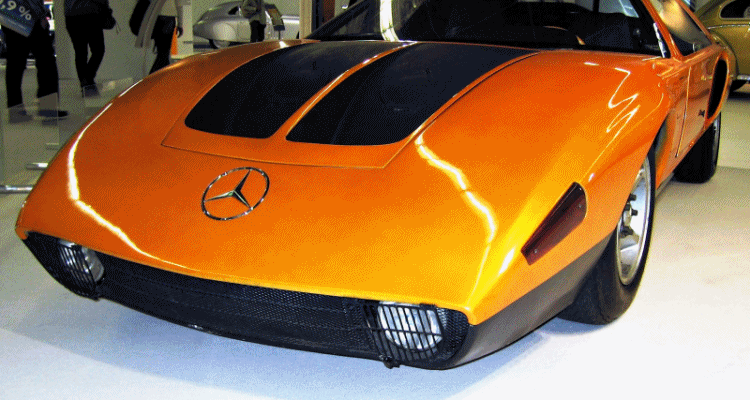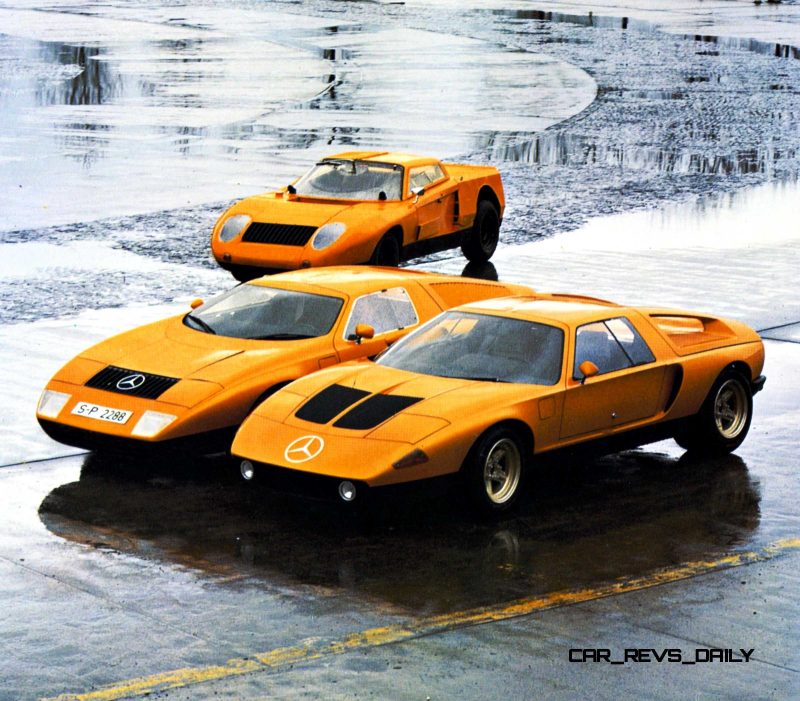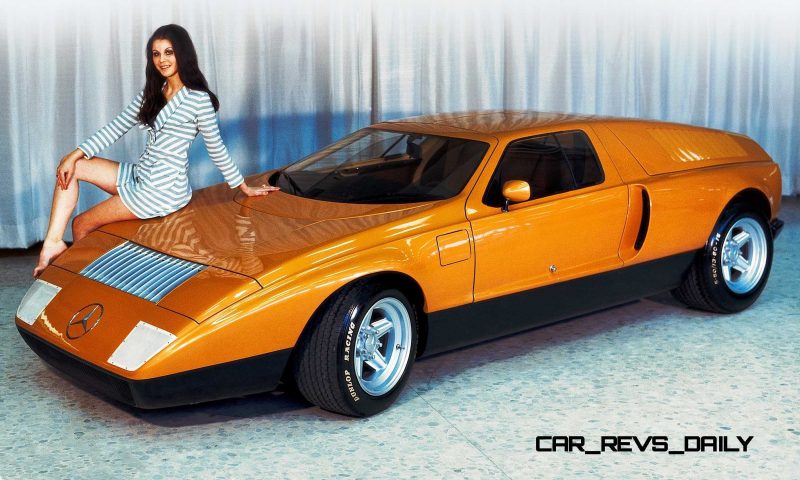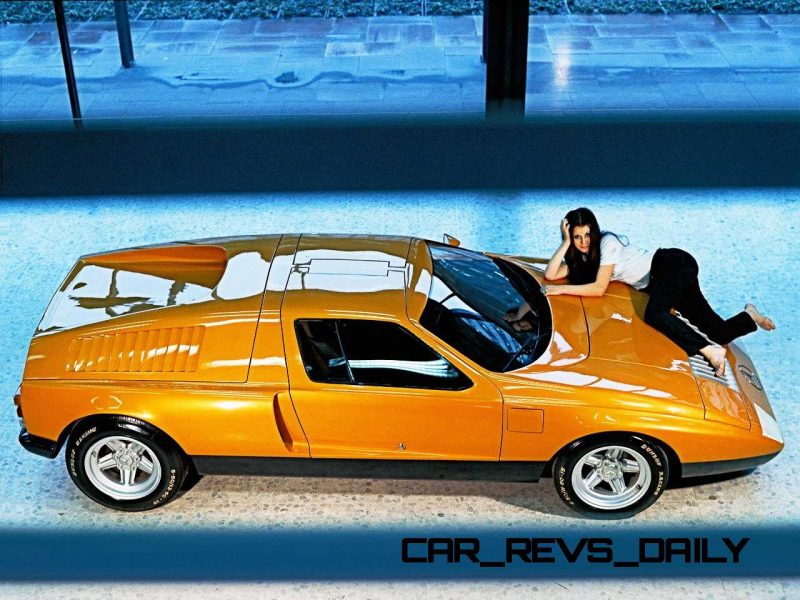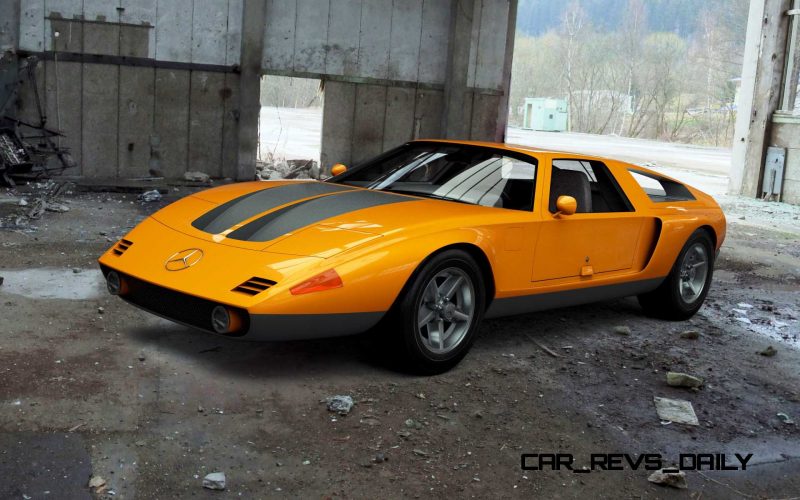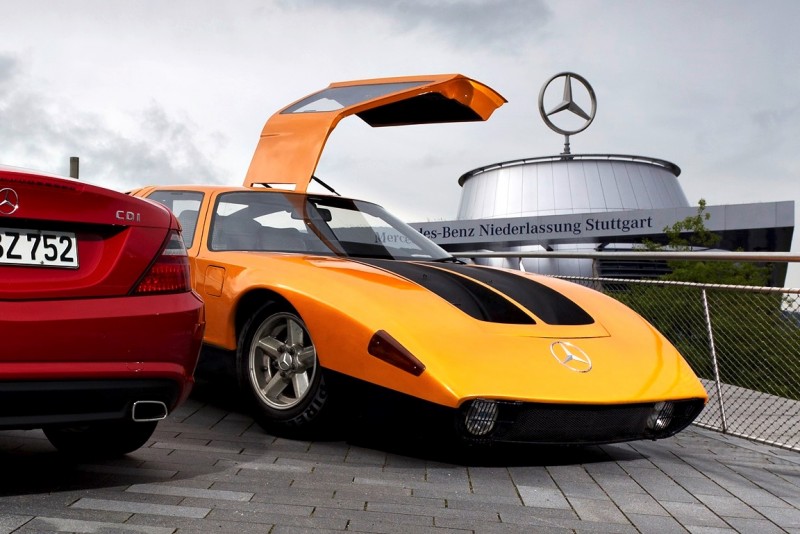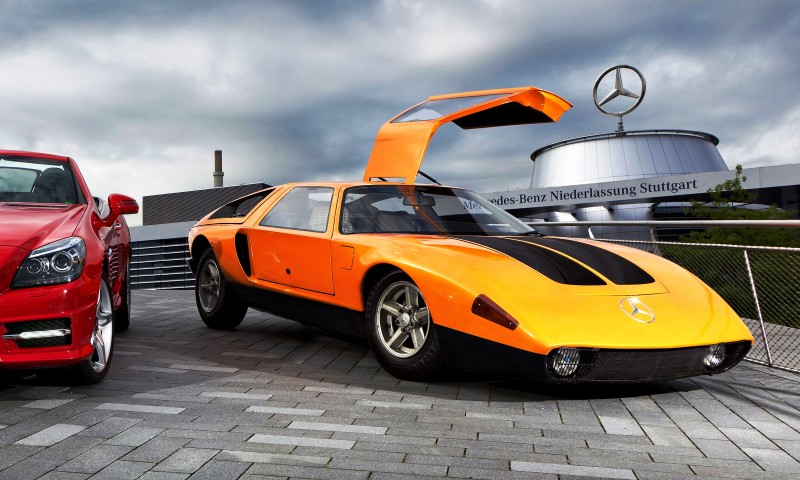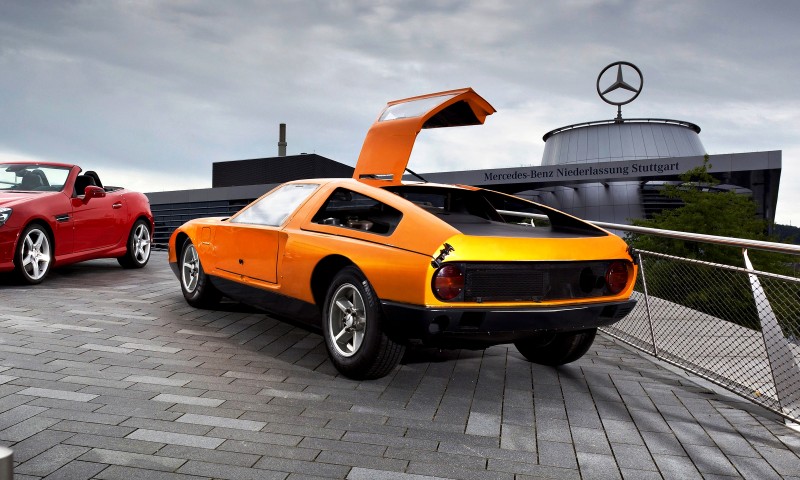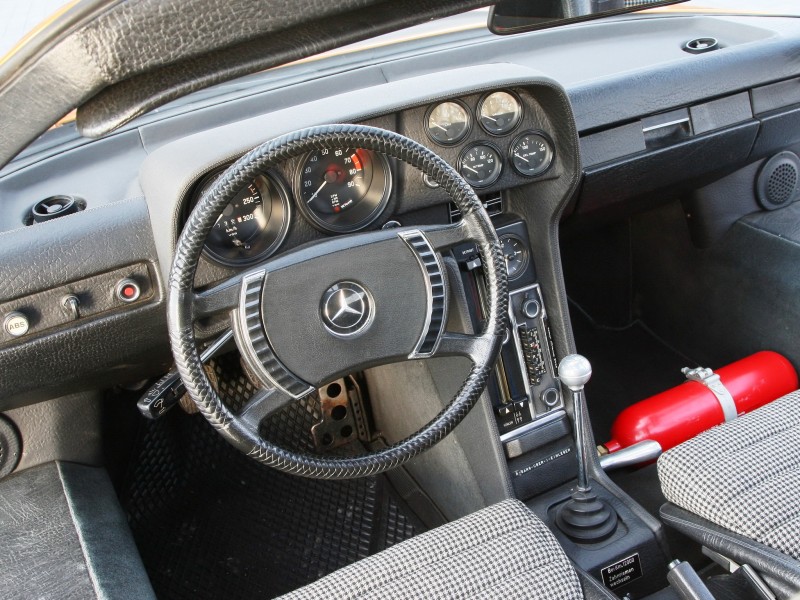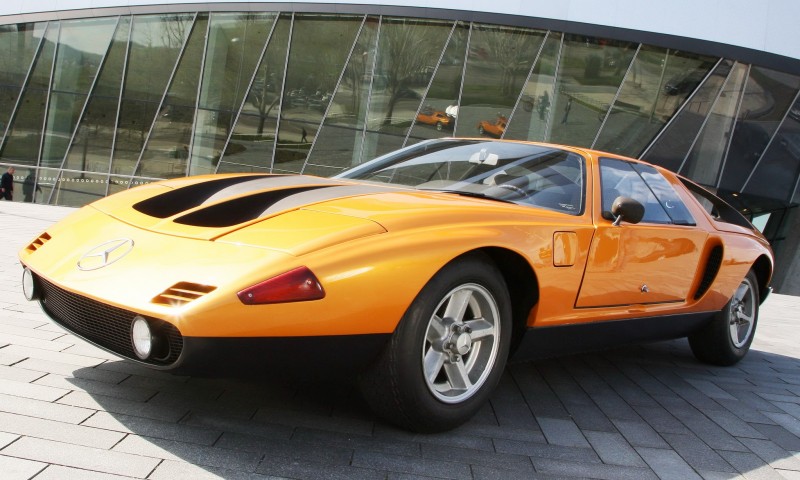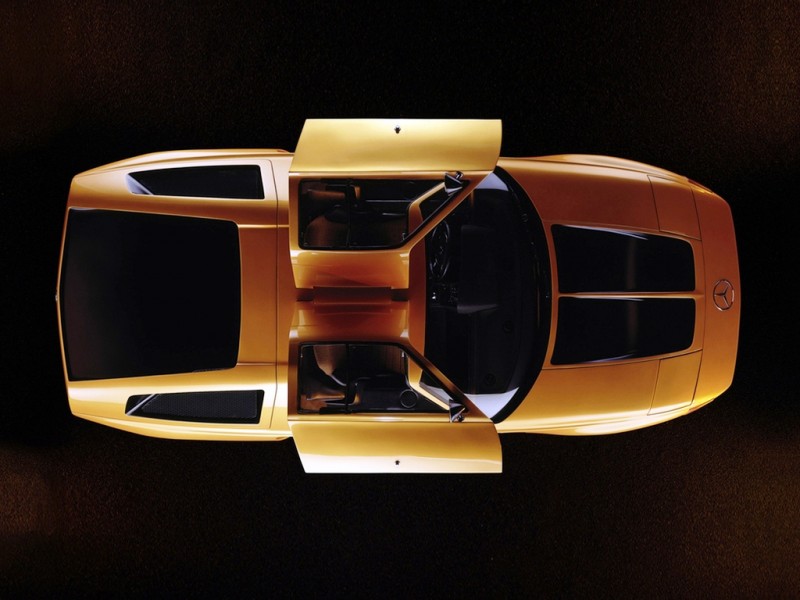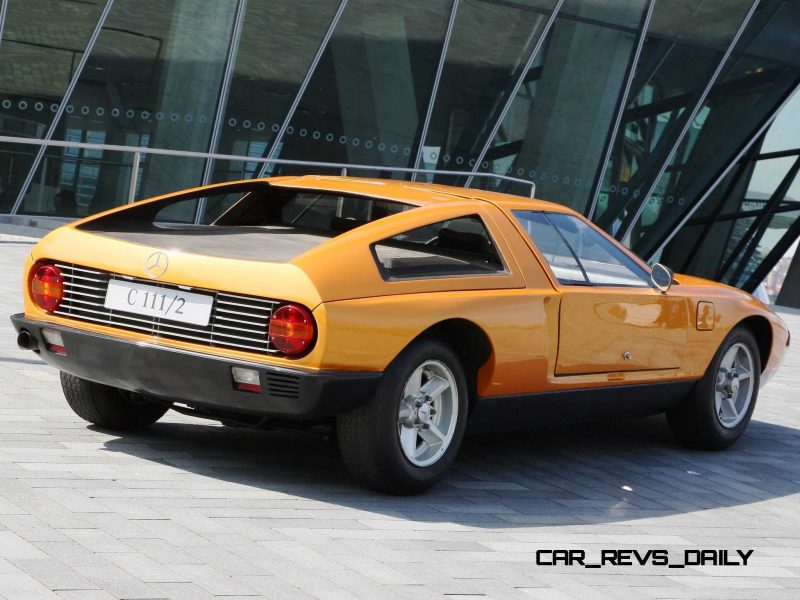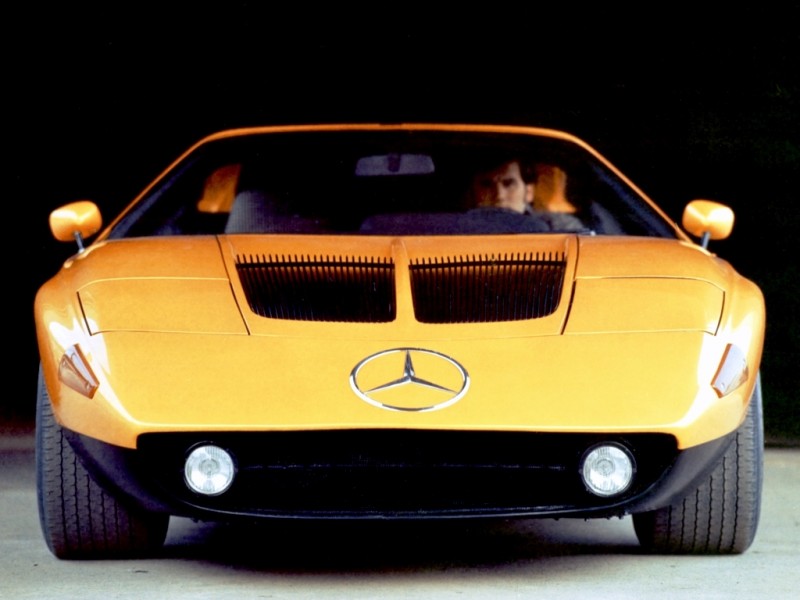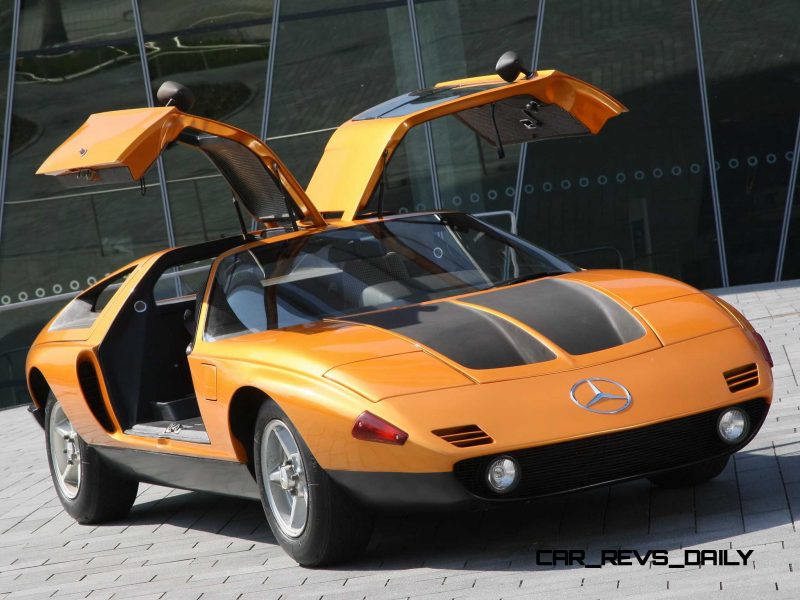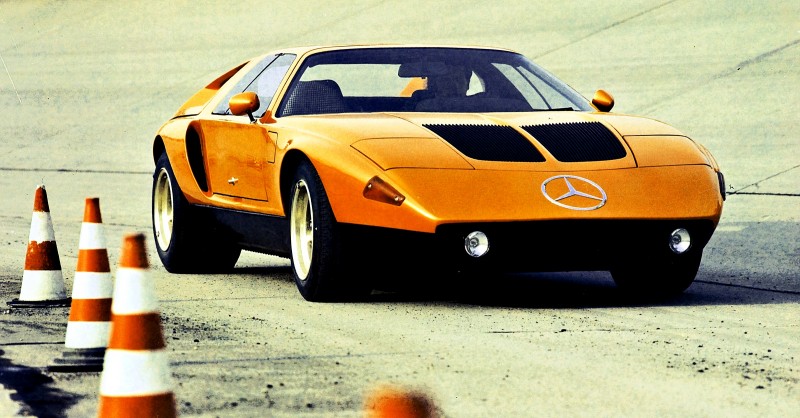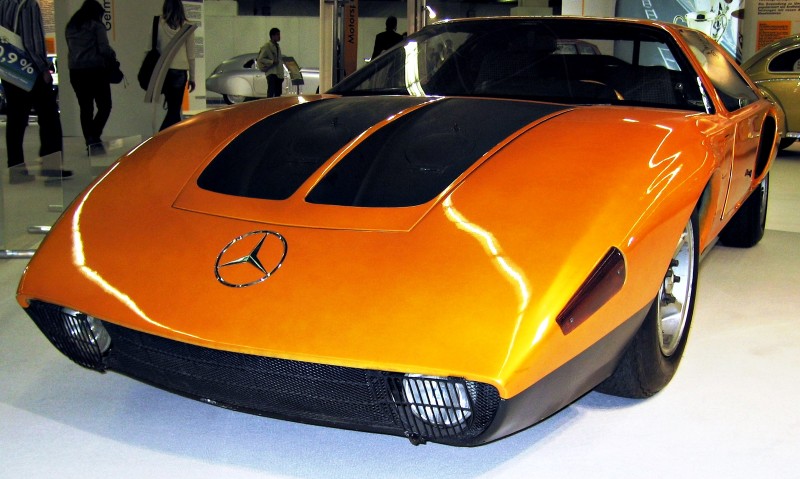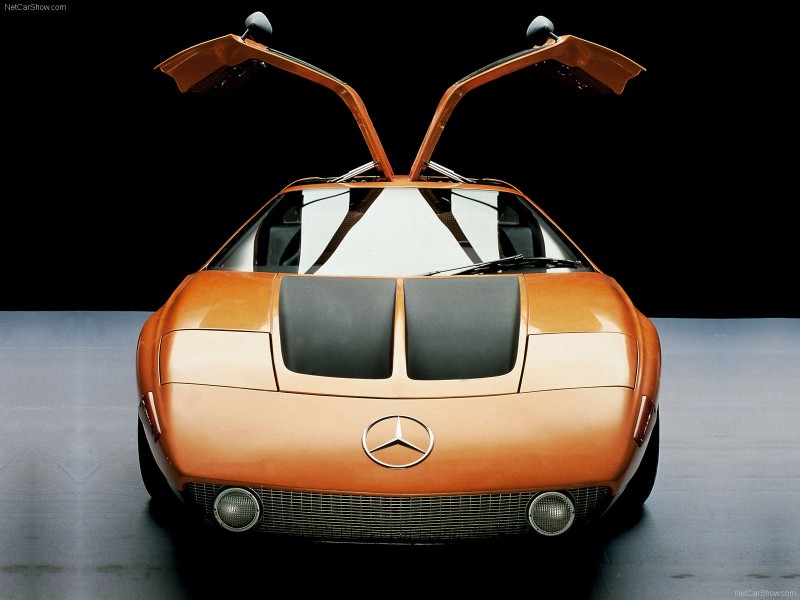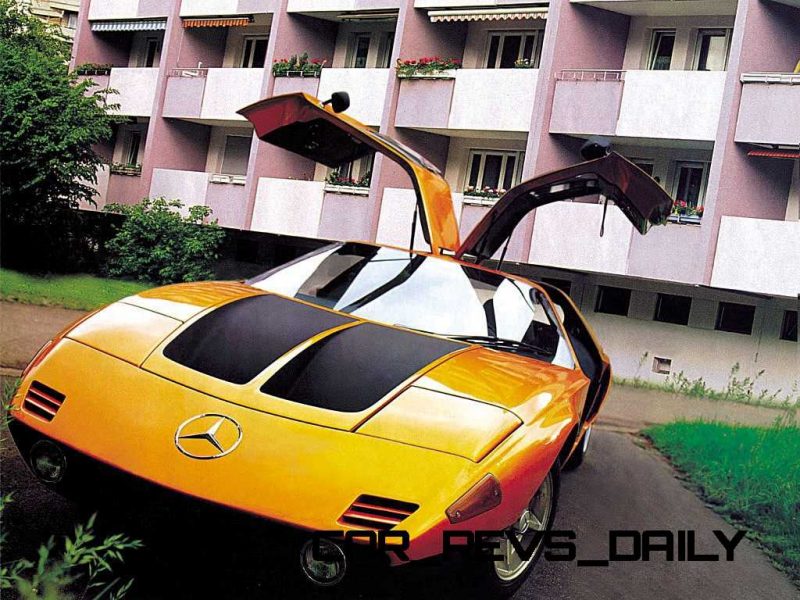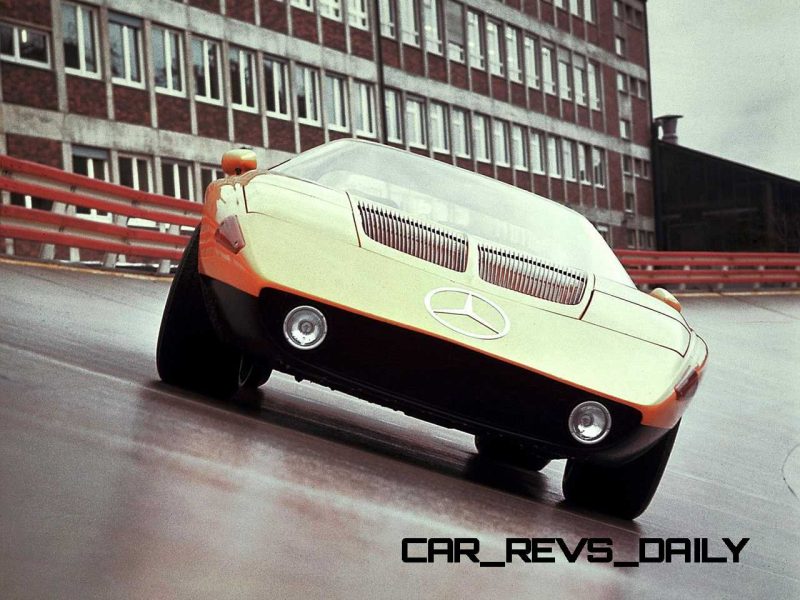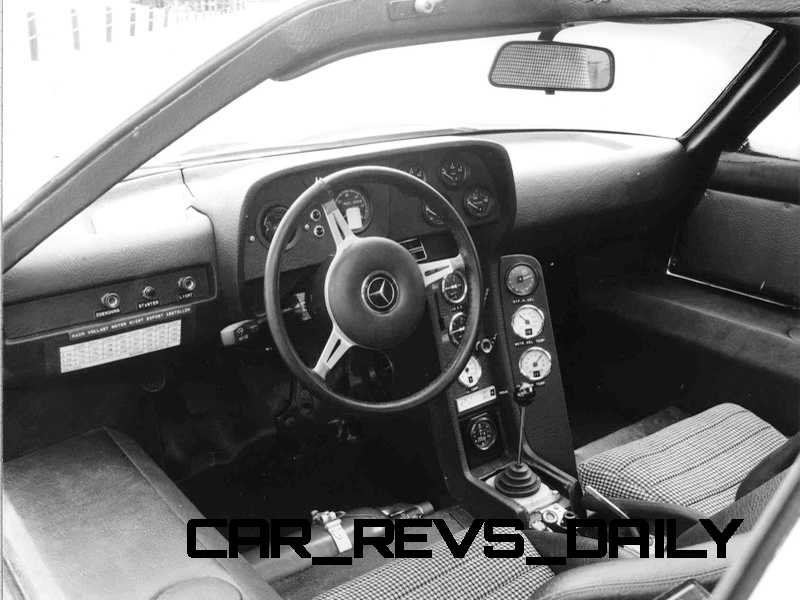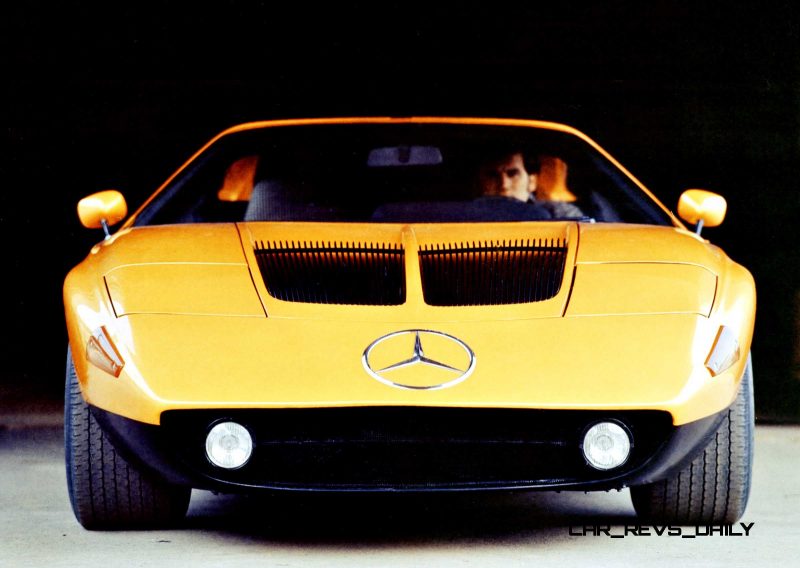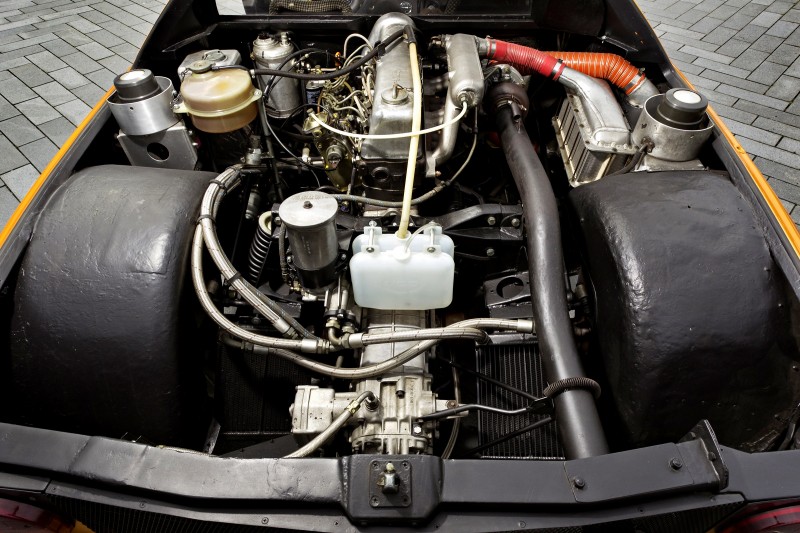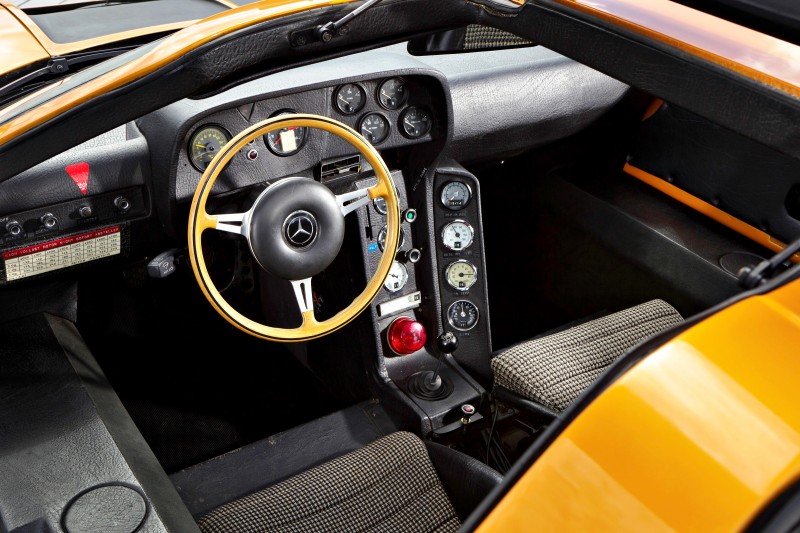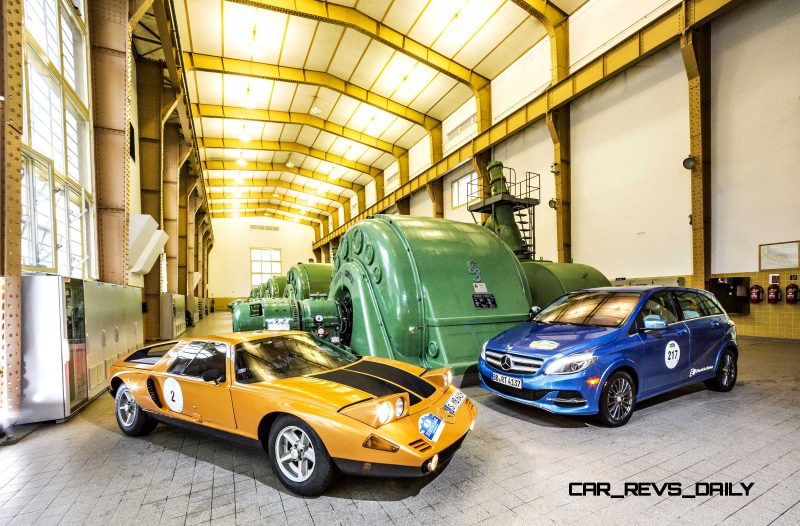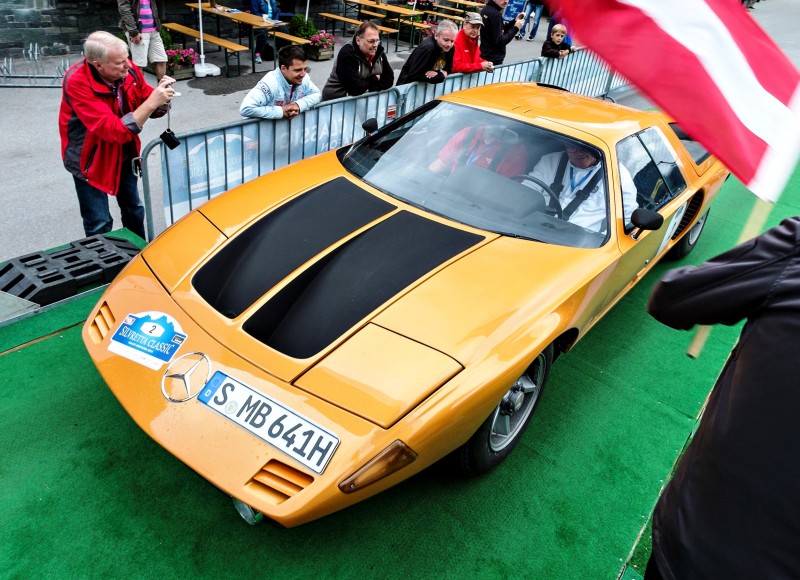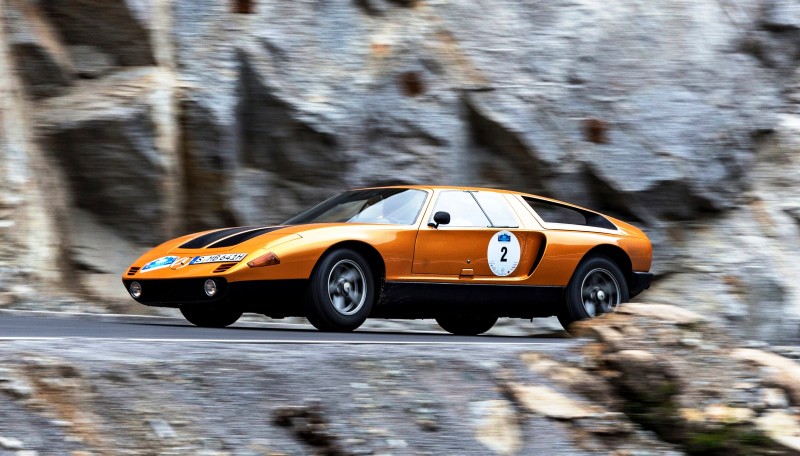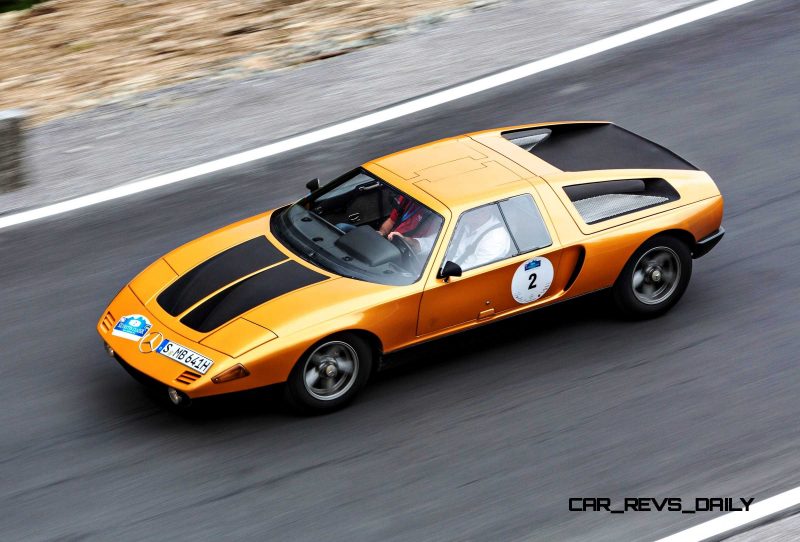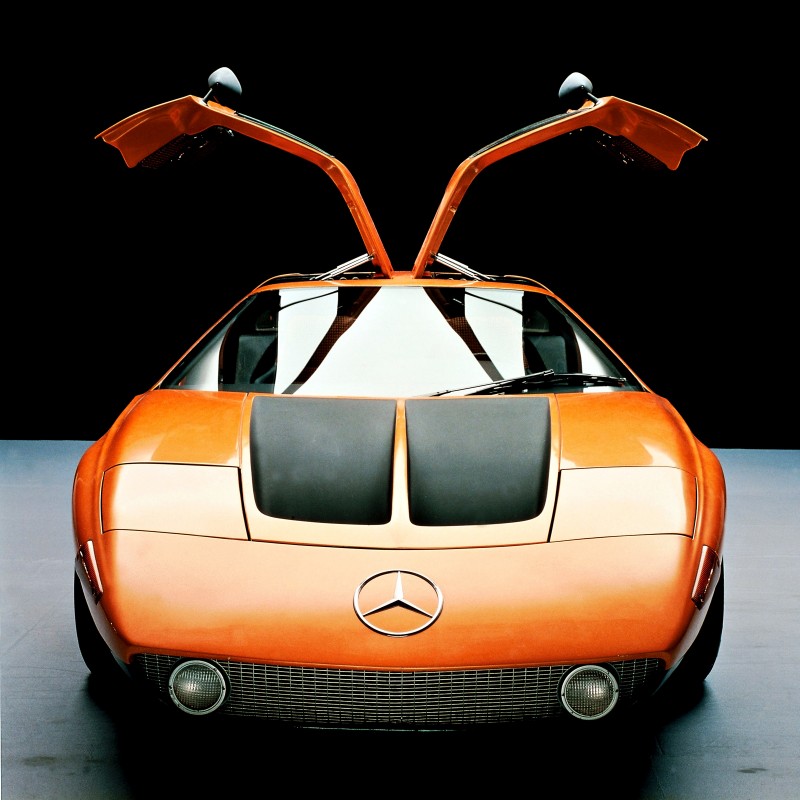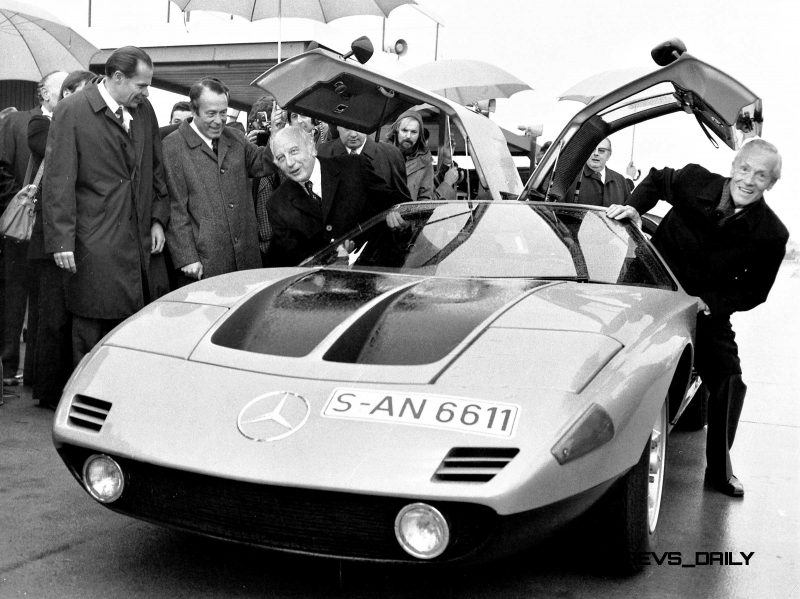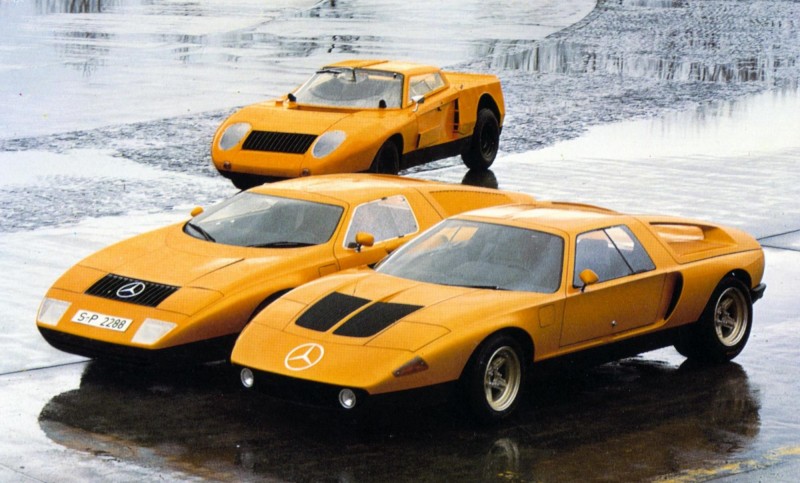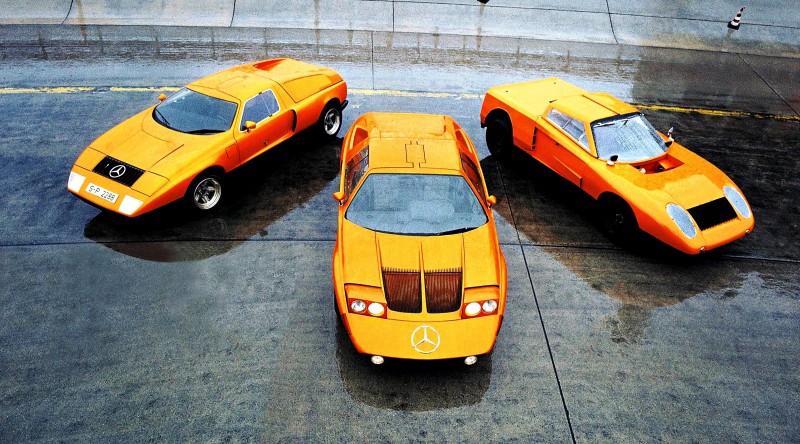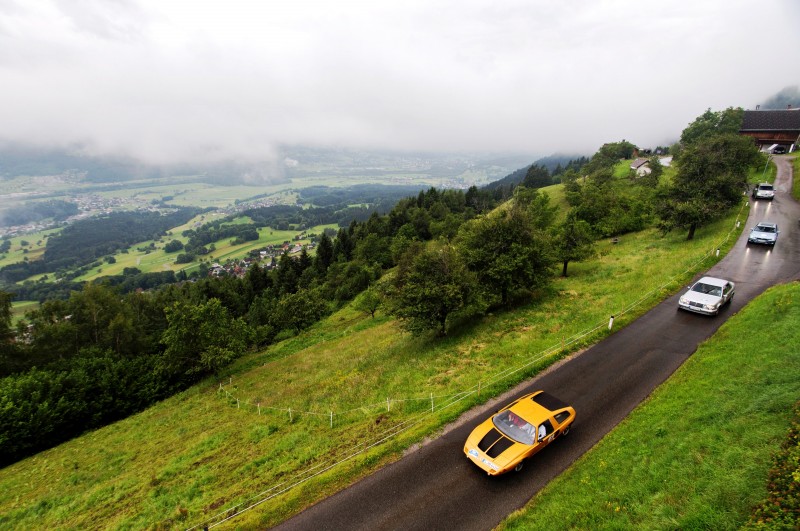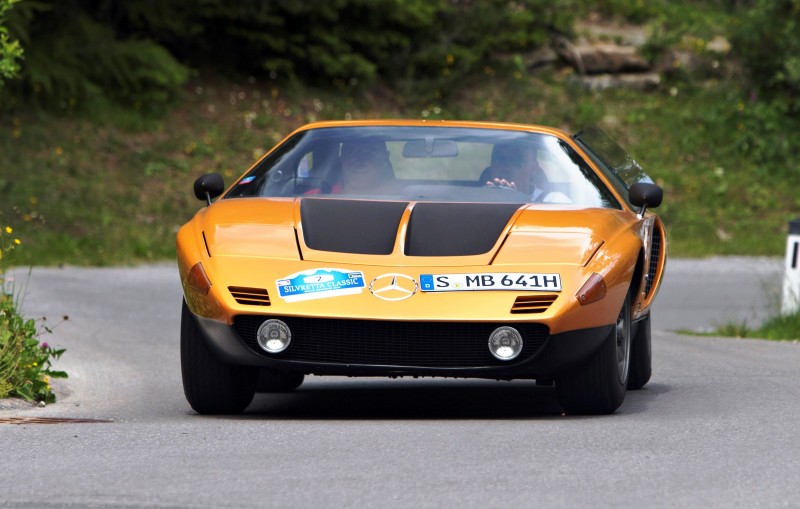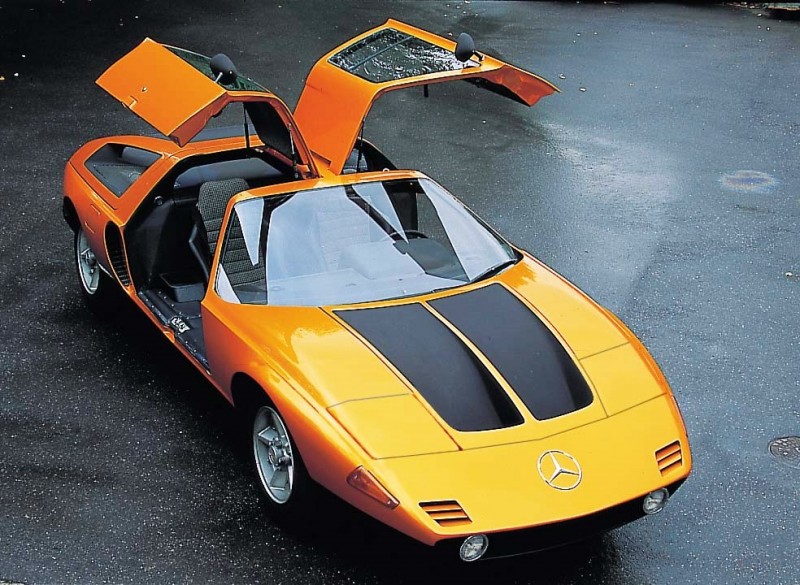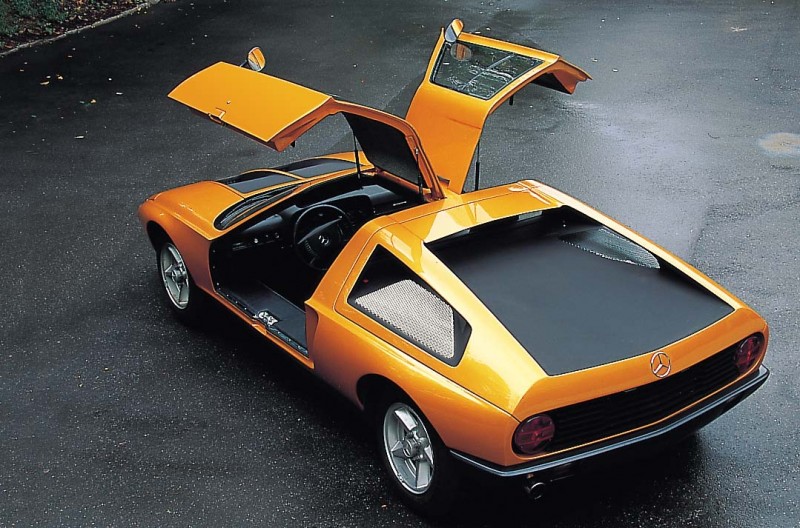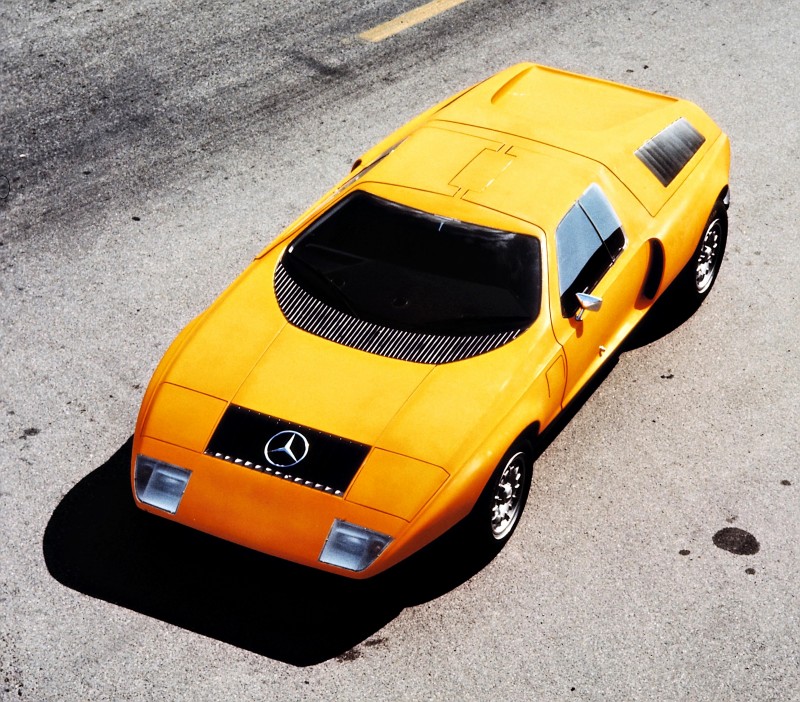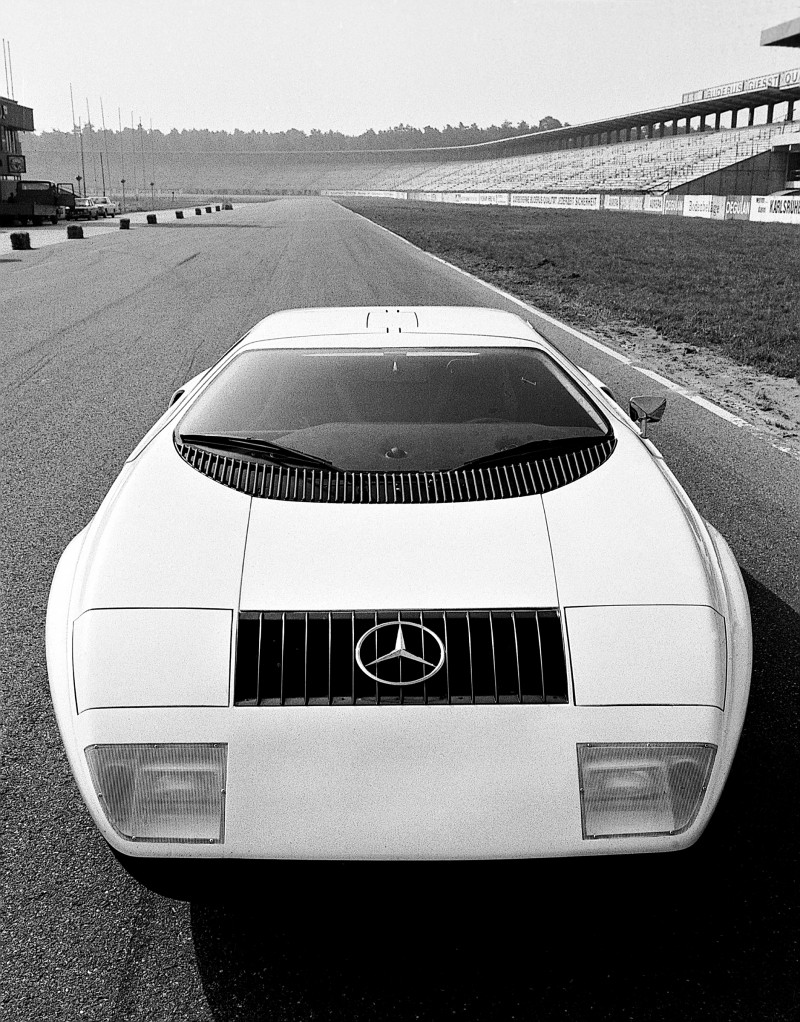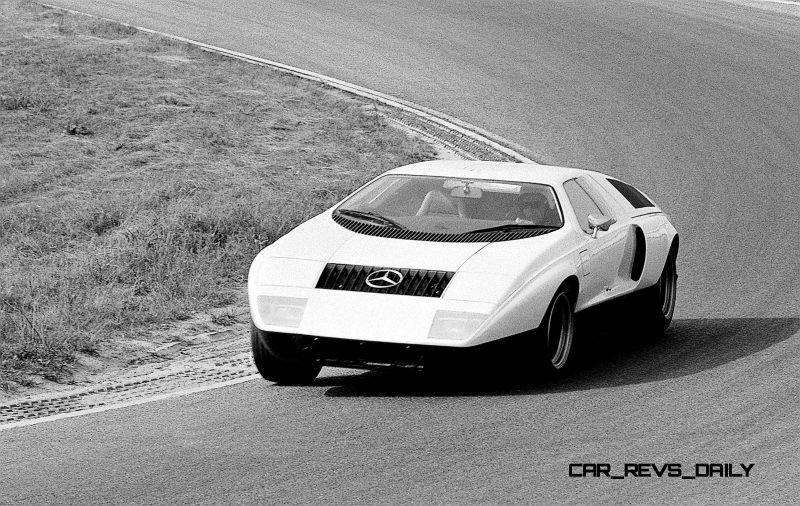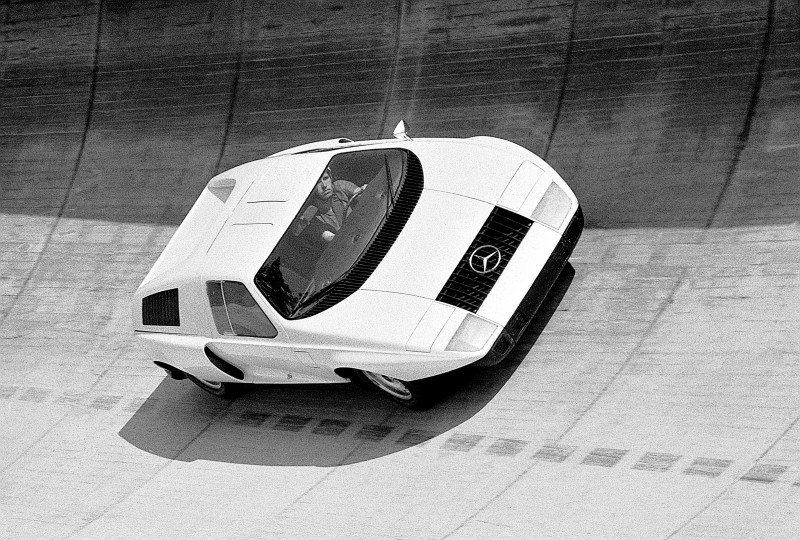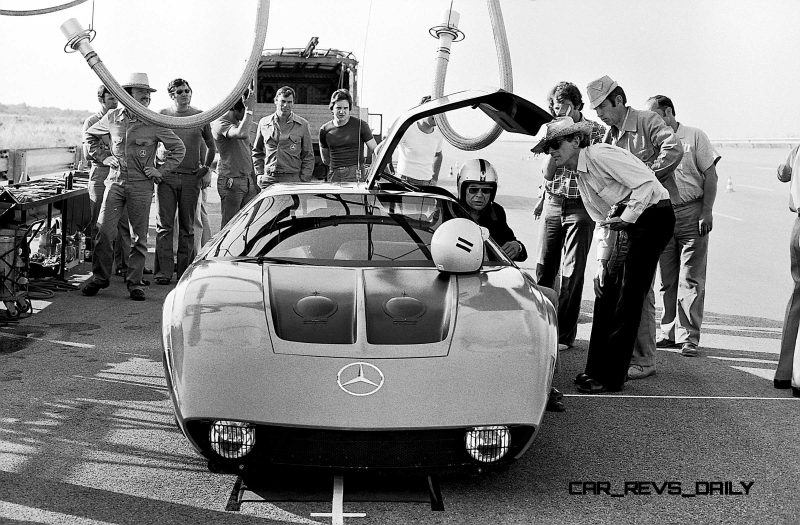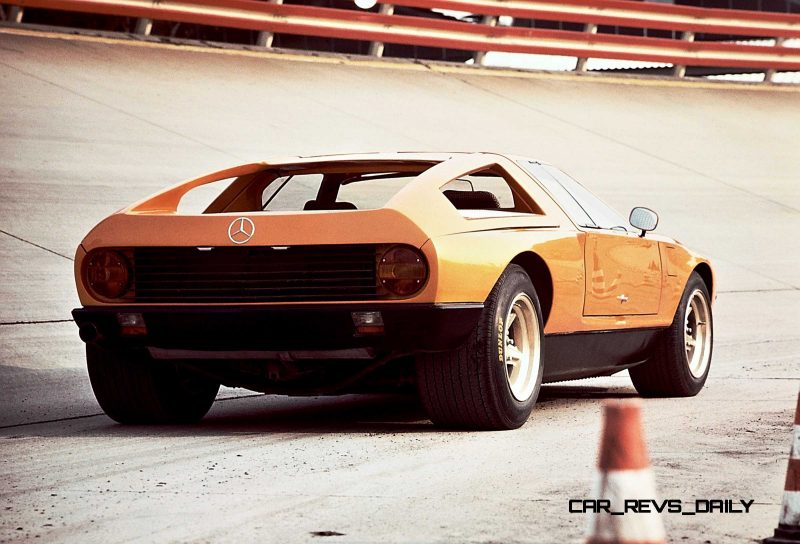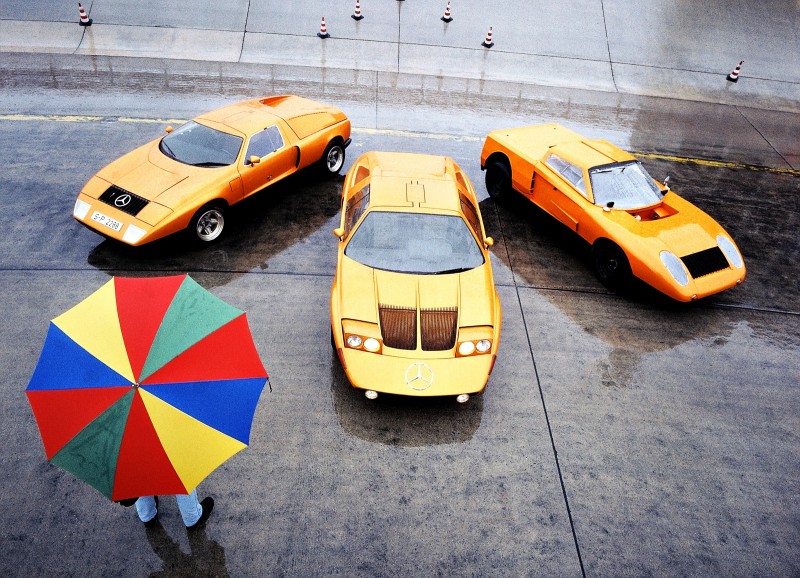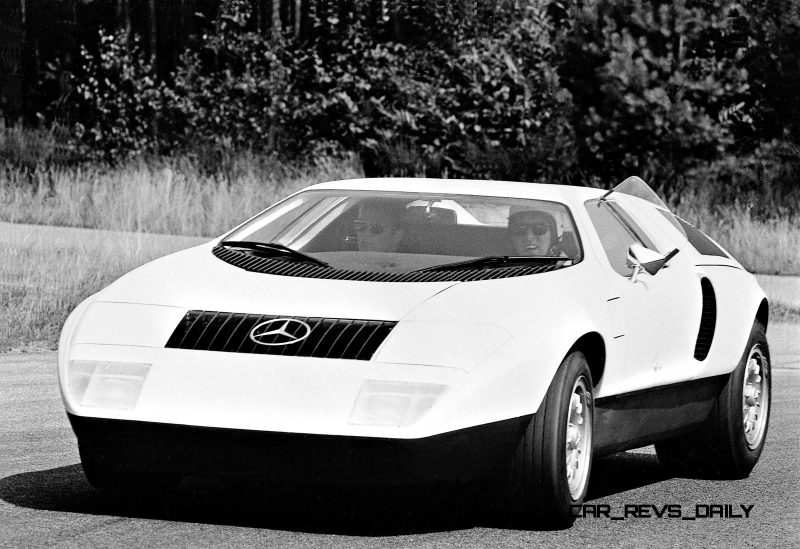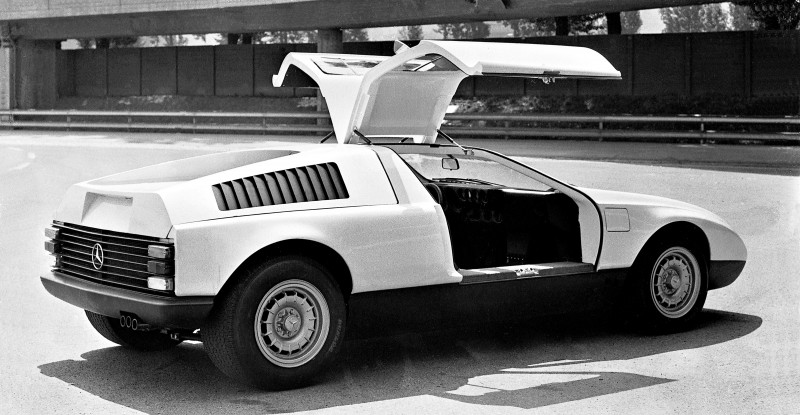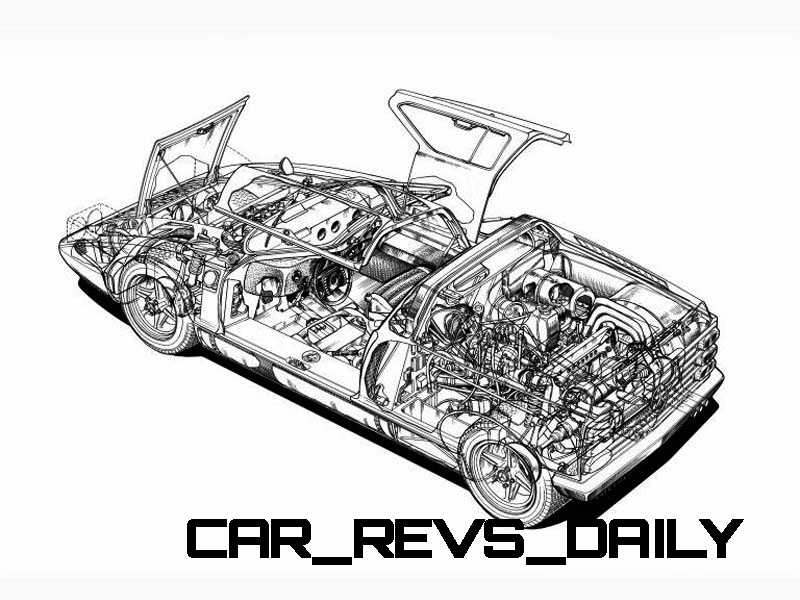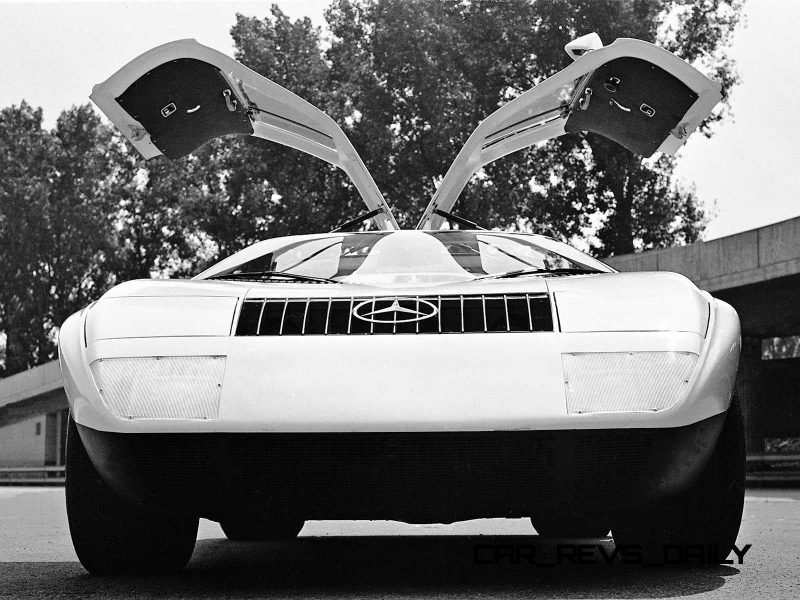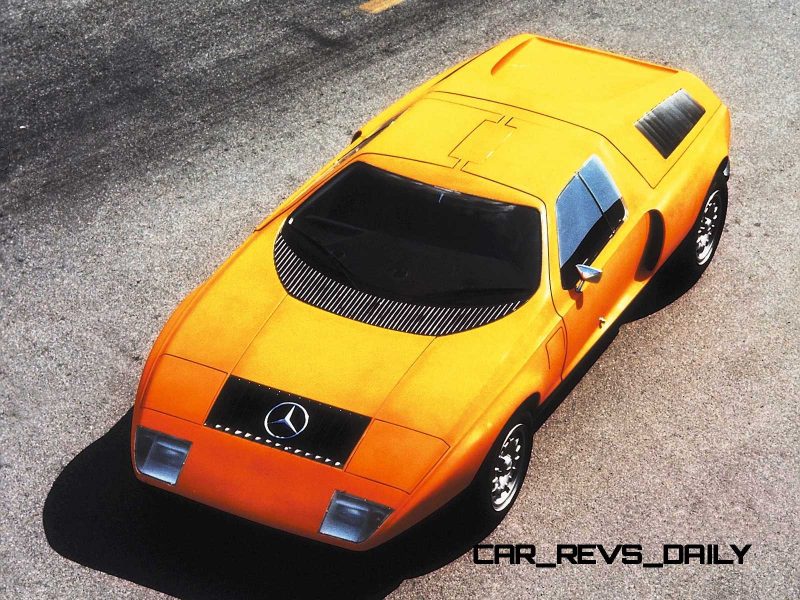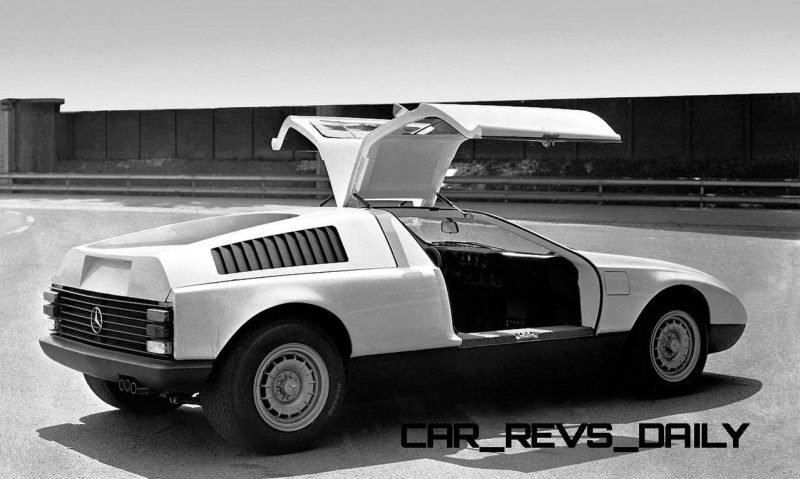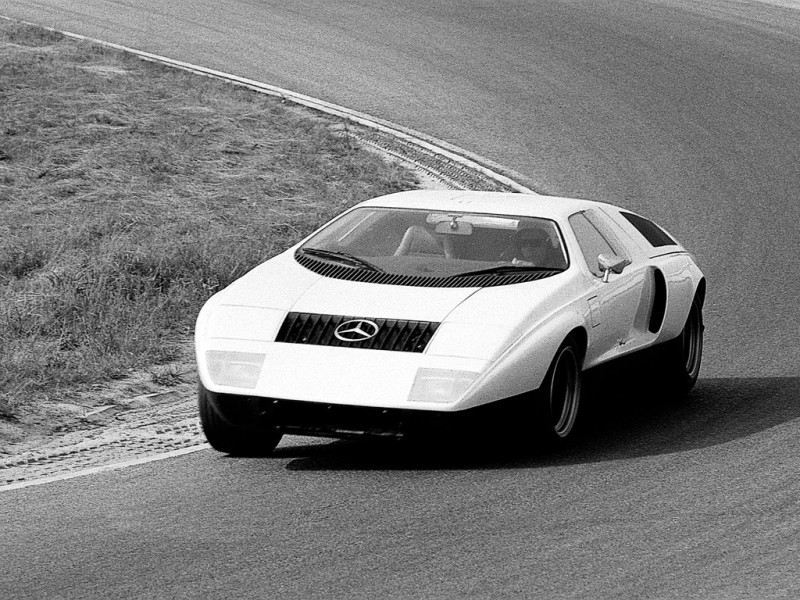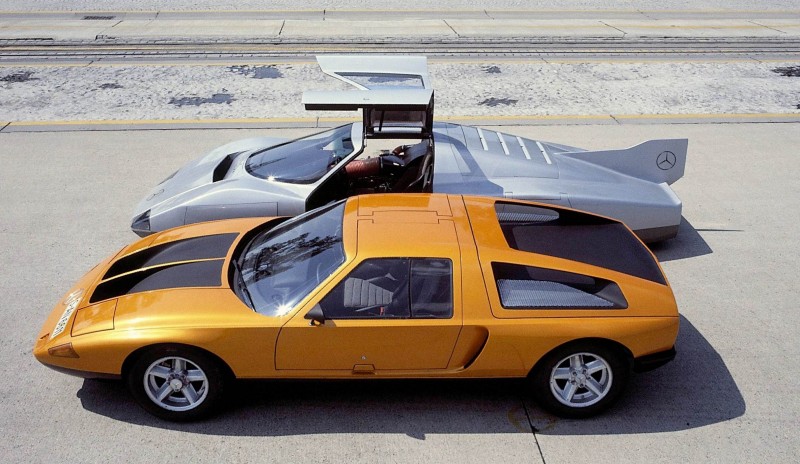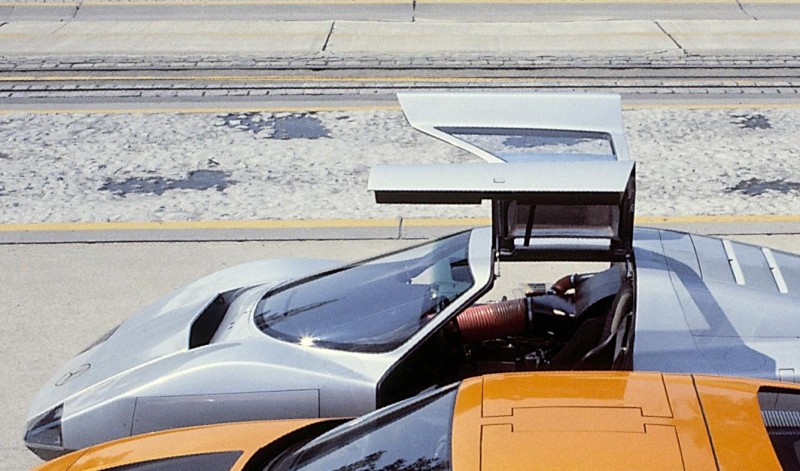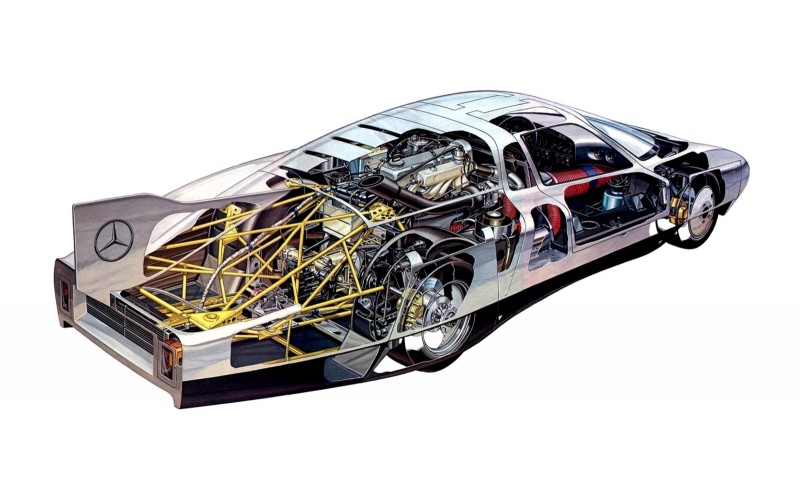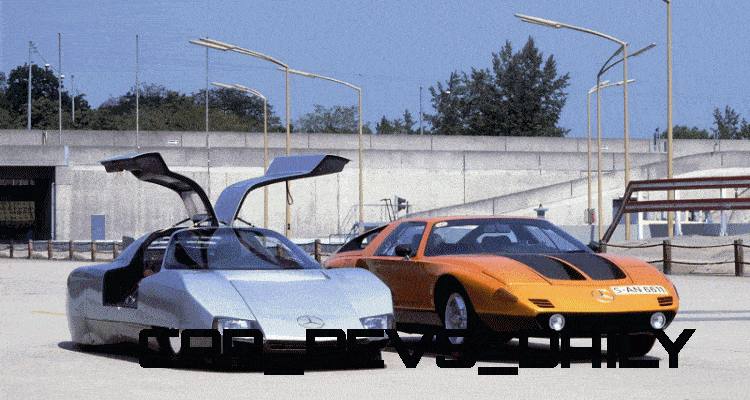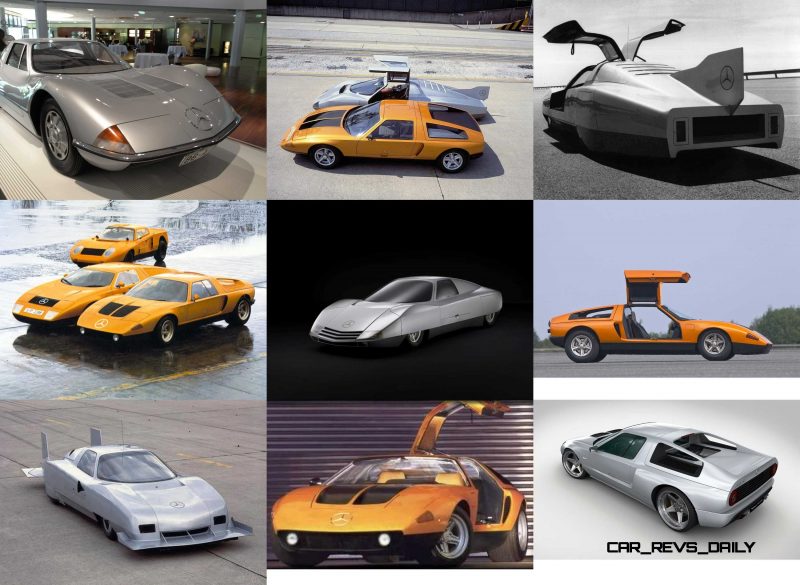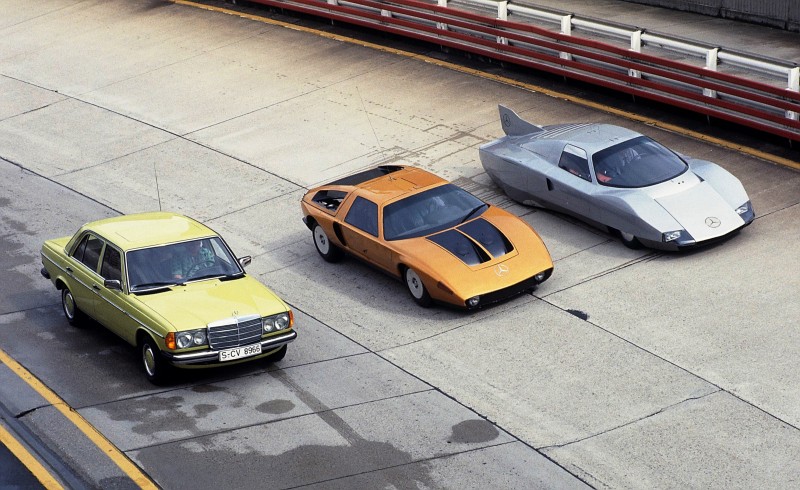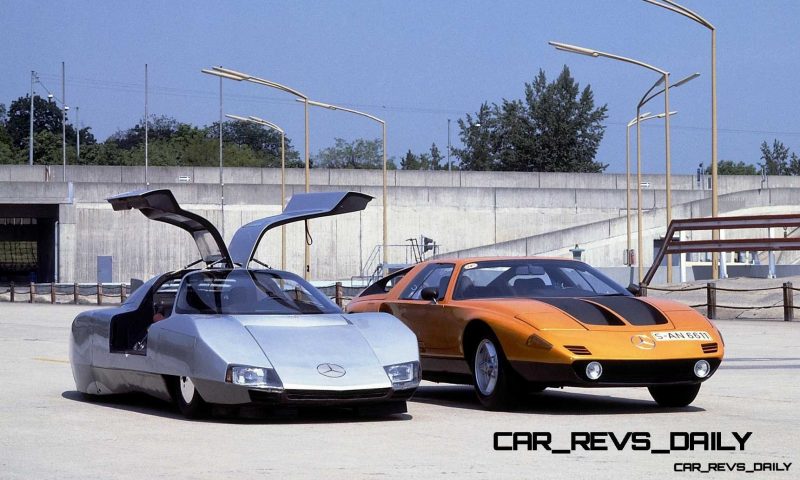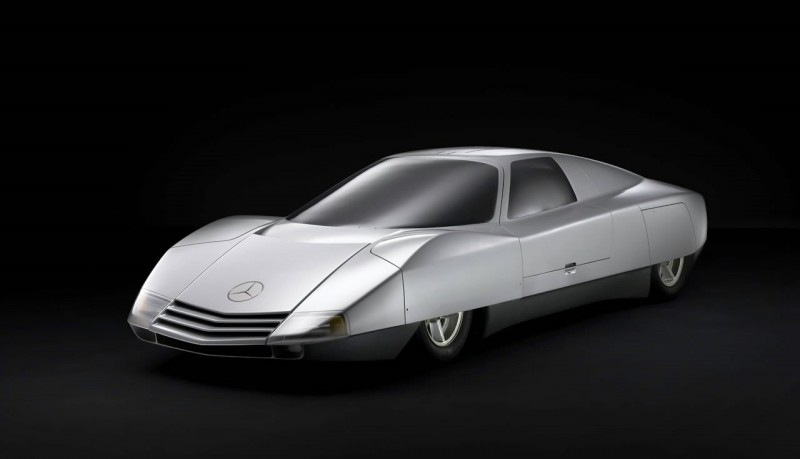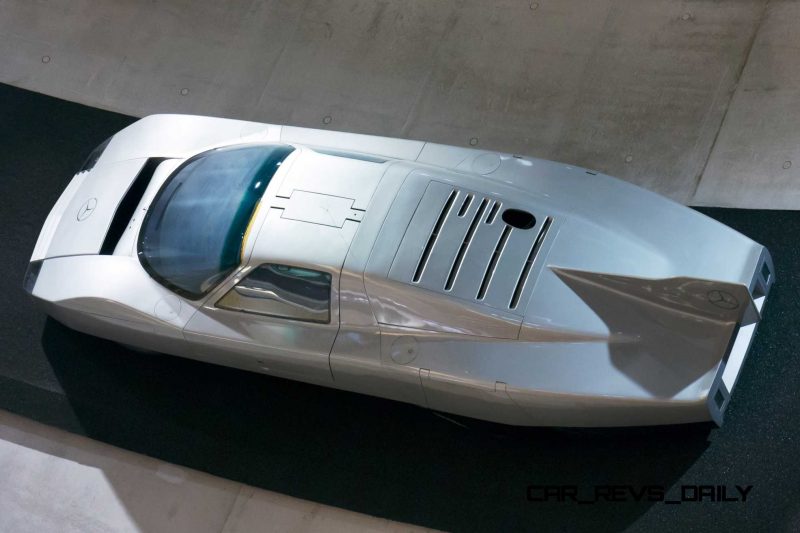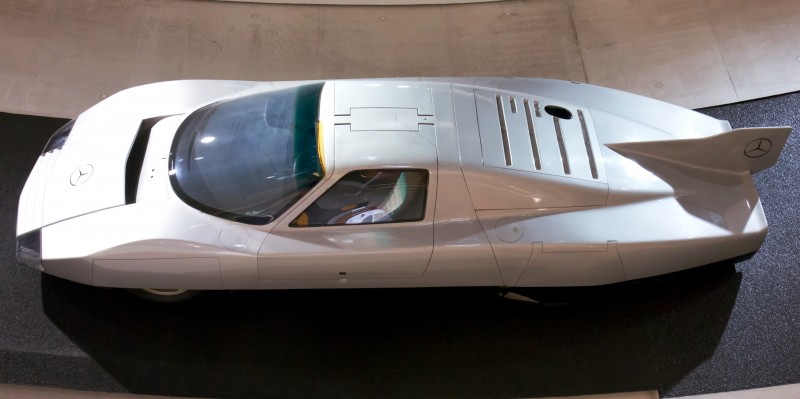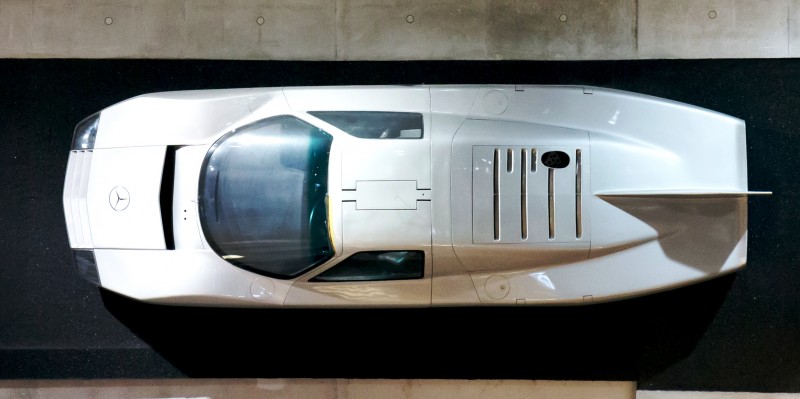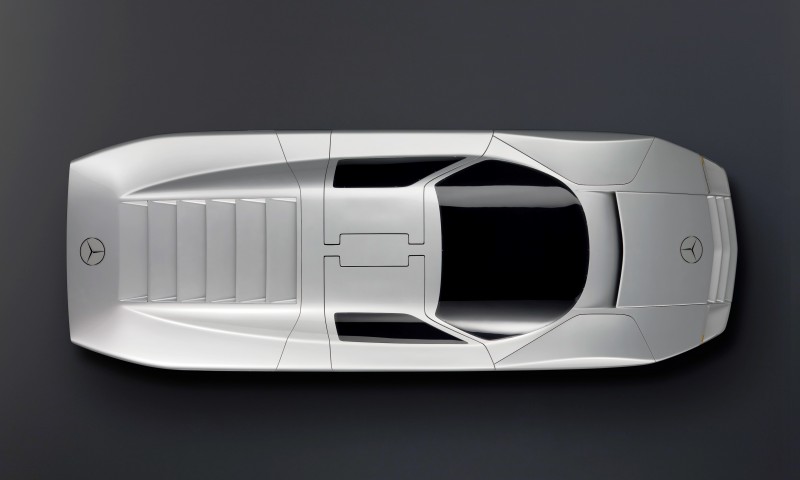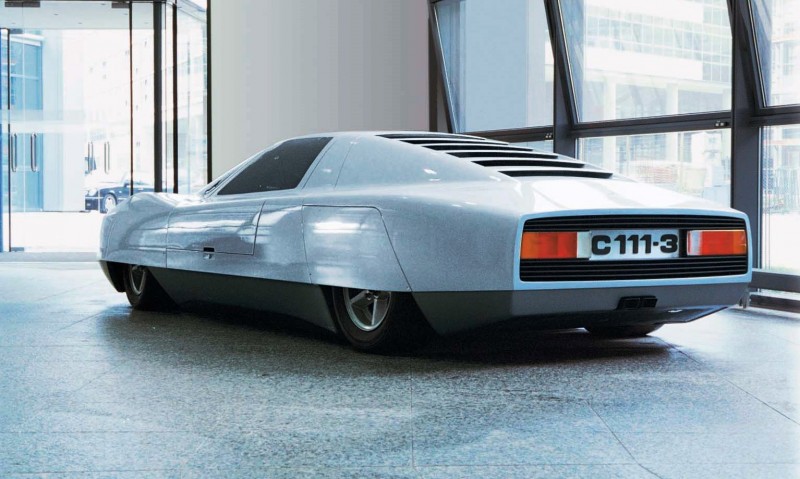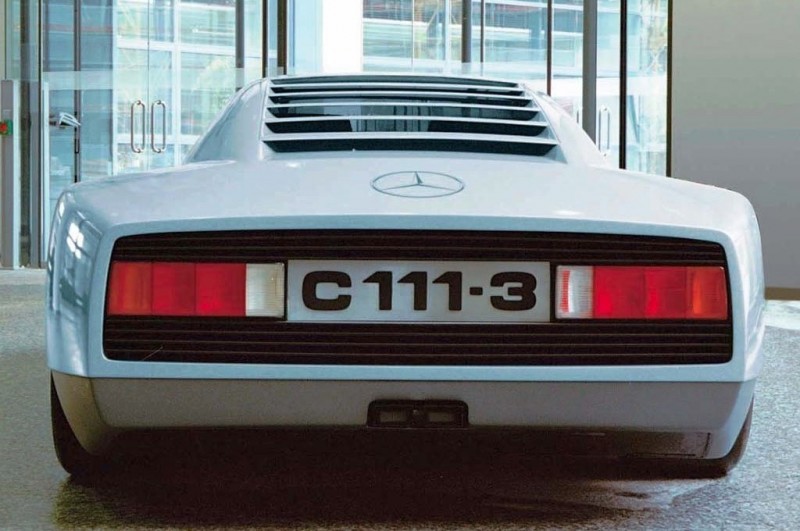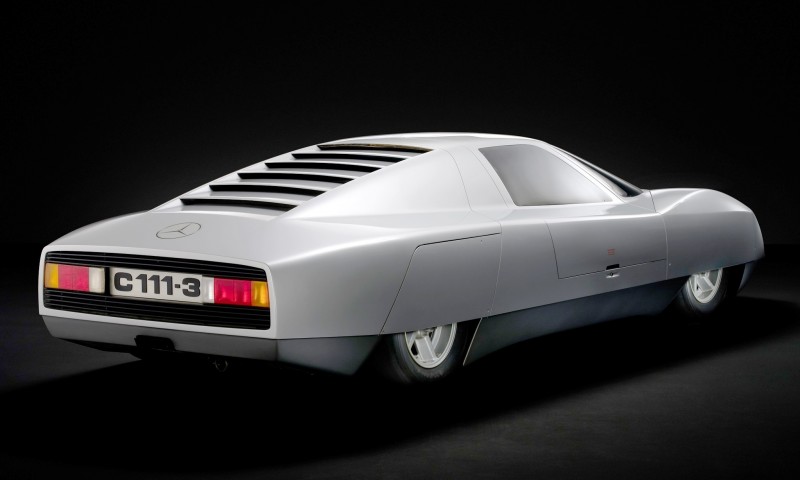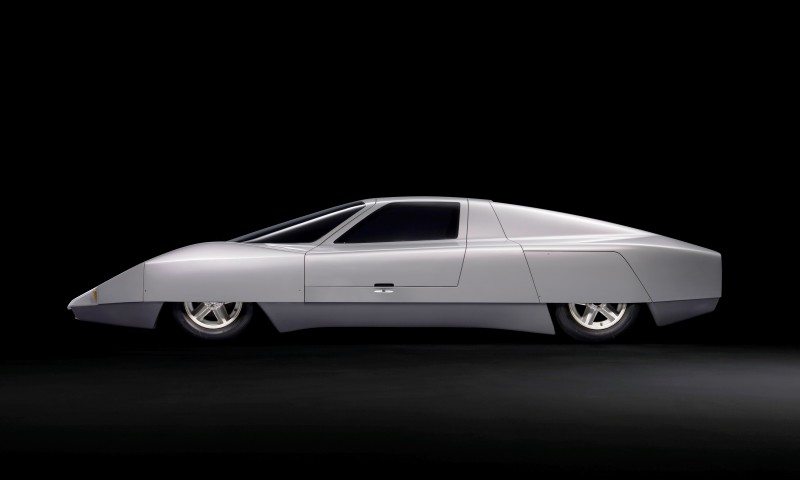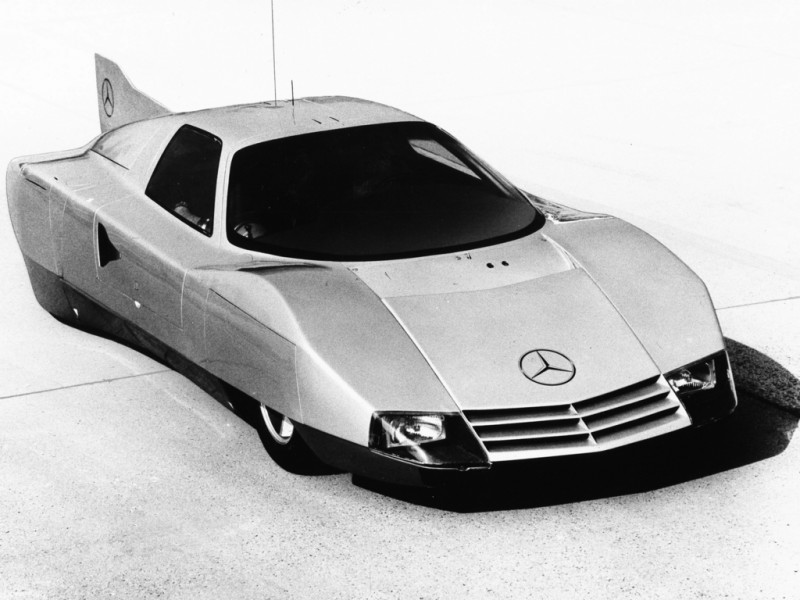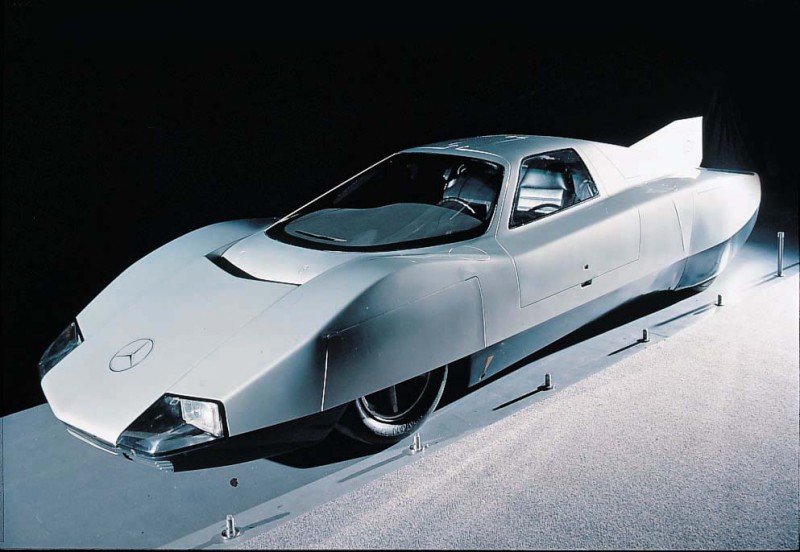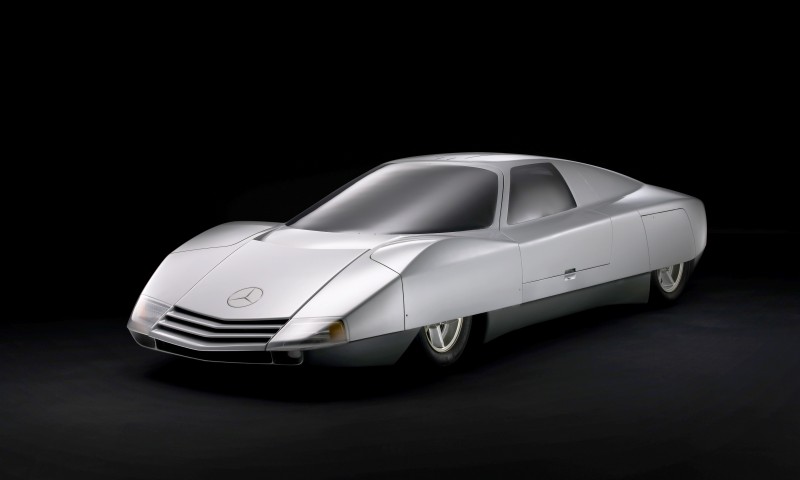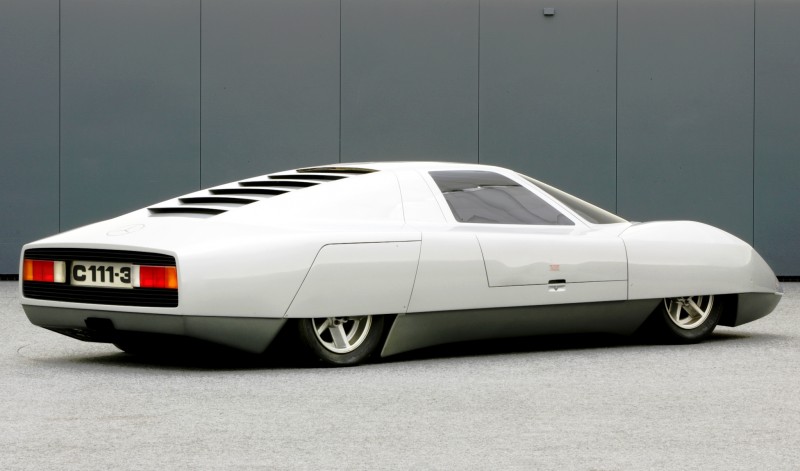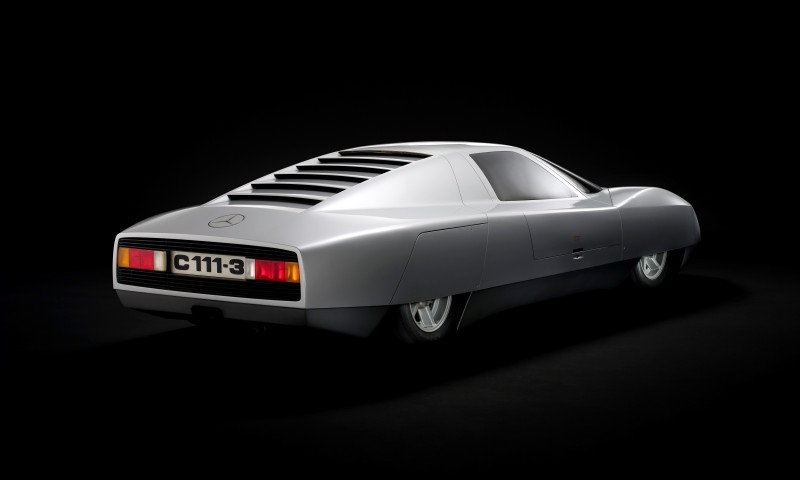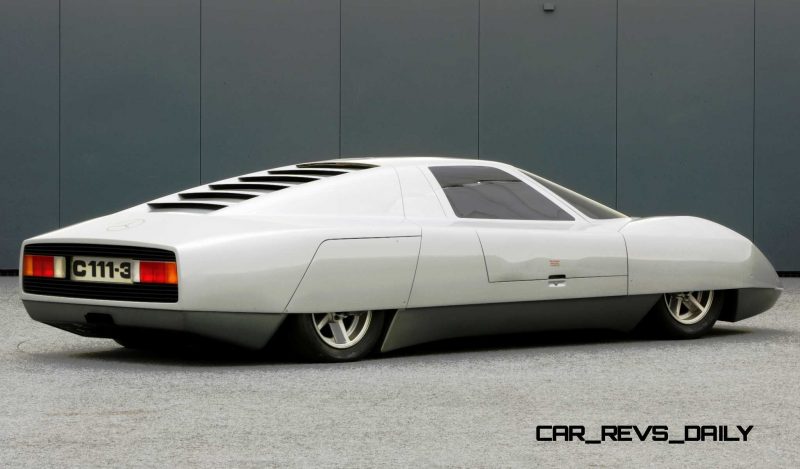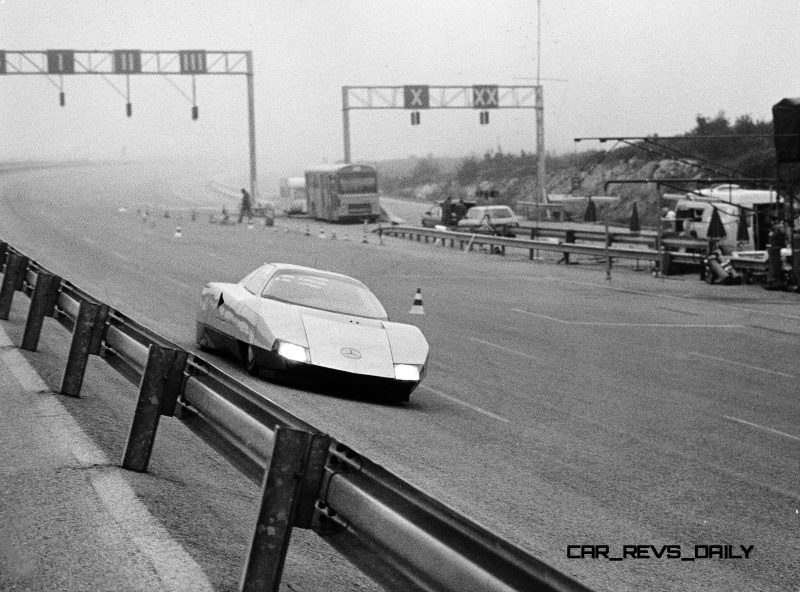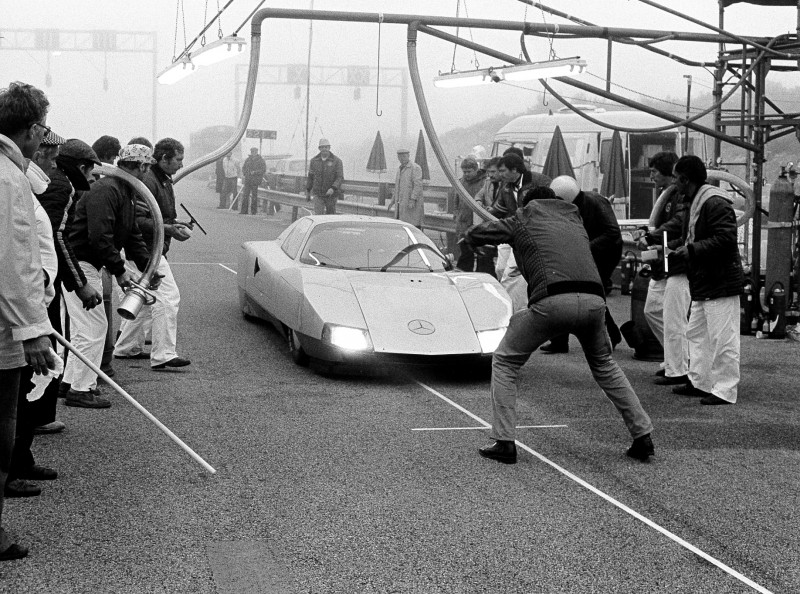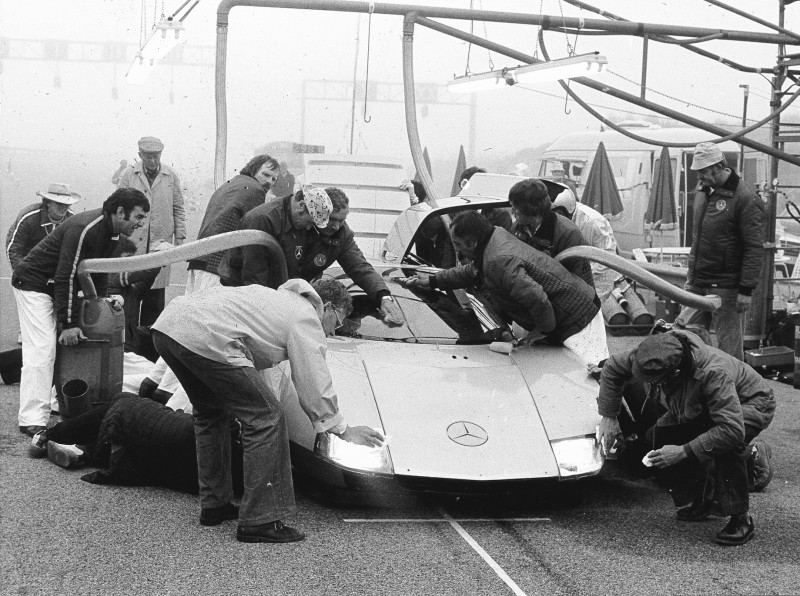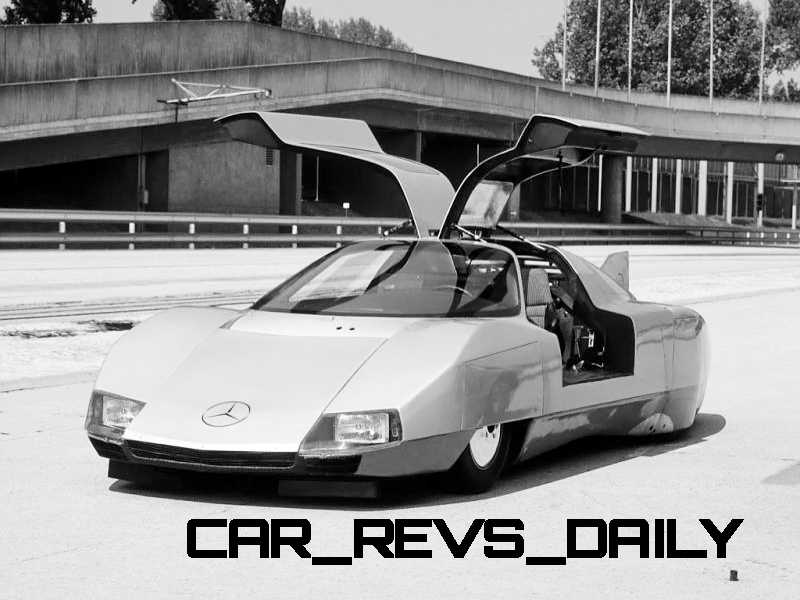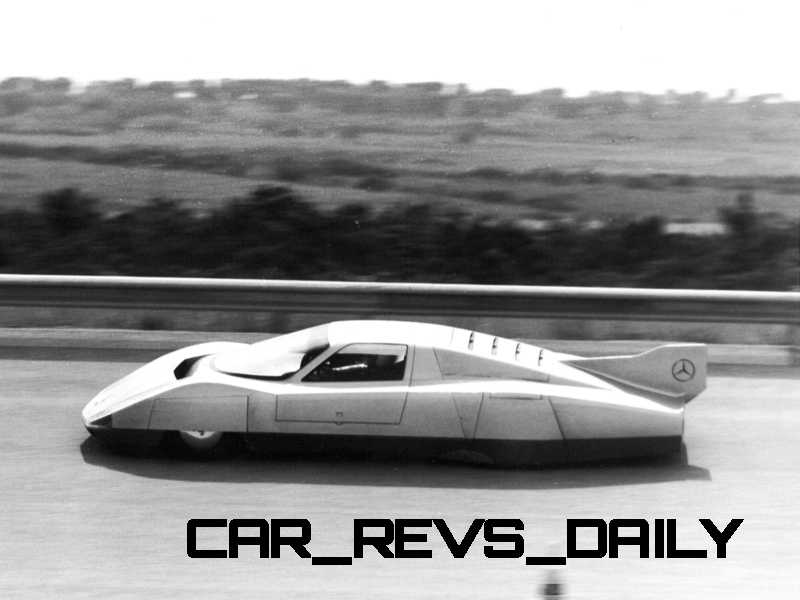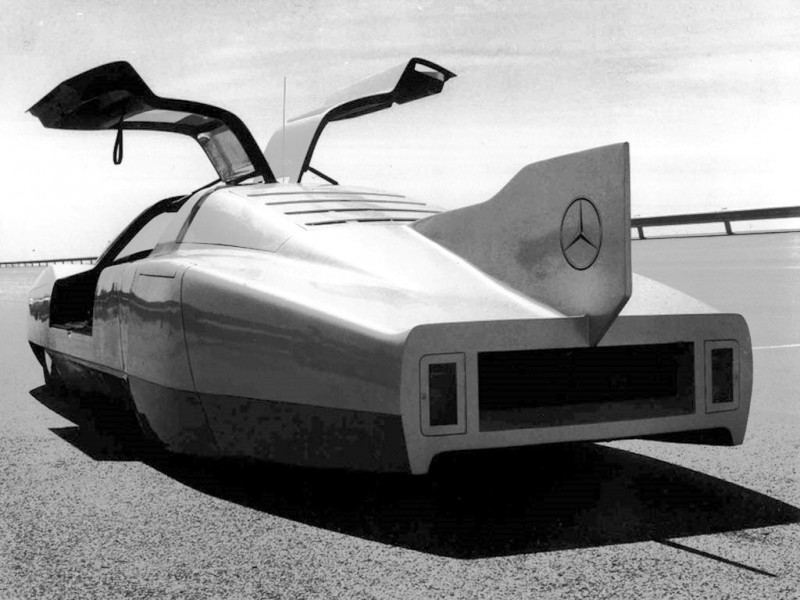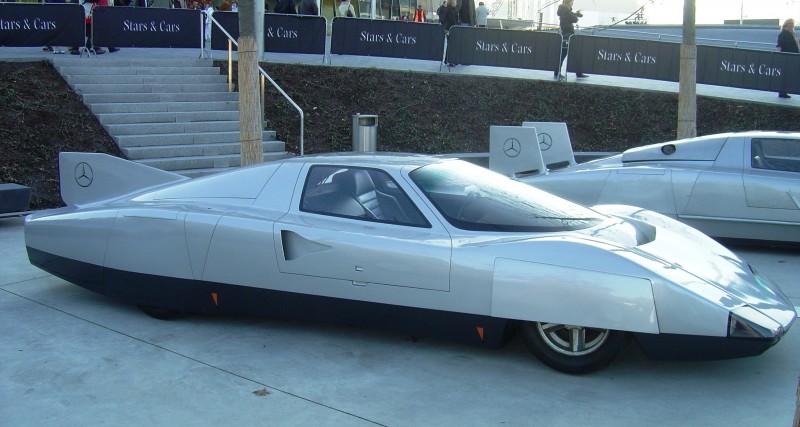 Updated 12.15.14
Updated 12.15.14
Including the first two C111 prototype designs here: the C111 proper from 1969 with a Wankel engine, and a C111-II running a 3.5-liter V8. The way to tell them apart is that the V8-powered C111-II has open spaces in the rear flying pillars, while the C111-I has louvered and solid-looking pillars.
1969 Mercedes-Benz C111 and 1970 C111-II
PREVIOUS
The Mercedes-Benz C111 was a sports-car vision revealed in the late 1960s with a slant-nosed, mid-engine design far removed from any Mercedes passenger vehicle. It was part of the continuing quest to broaden the Mercedes brand into new segments, in this case the supercar market.
We will cover the orange-colored C111 and C111-2 models in a later article.
This post is dedicated to the much-later iteration on the theme from 1977 and 1978.
The original C111’s Wankel engine was shelved indefinitely by the early 1970s, and production of the car was a non-starter due to dramatic Wankel failures in Audi sedans in the late 1960s. This almost sunk Audi overall, by the way, and Mercedes wanted to avoid the same fate, understandably.
A revolutionary new diesel five-cylinder engine with advanced Bosch fuel and electronics systems was proven in 1975 and ran around in a normal Merc sedan as its prototype. But this diesel was fast and super powerful compared to all others before. Electronic fuel injection finally made turbochargers able to live up to their potential, doubling power outputs of diesel engines almost overnight.
Mercedes needed a light and sporty prototype chassis to really prove how amazing this new diesel was to the world. Plenty of C111 shells were still around, and the engine compartment was just the right size for the new 240D engine making 190-horsepower.
Mercedes found that the C111-III was faster than anyone ever expected.
And suddenly the long-held German dream of high-speed glory came flooding into the present. Let’s set records, they exclaimed!
Over the next few years, the C111-III evolved at warp-speed to implement not just this diesel, but all of Mercedes’ latest knowledge on lightweighting, aerodynamics, and safety tech. No one wanted a repeat of the tragic 1930s V-max record runs, so crude ABS and extreme attention to downforce and anti-lift were a big part of the program.
The aero refinements were extensive, with flush shutlines and shrouded block headlamps that were unheard-of at the time for production cars. The cD achieved by the C111-III is still impressive today: just above 0.183 is super sleek.
How serious about aero? This giant red tube fed air from the nose back toward the engine – passing right through the cabin en route.


The C111 became longer, more streamlined and eventually decked out with wings, splitters and aero additions galore.
All this effort and expertise worked: the C111-III set more than a dozen diesel speed records, and three overall records for any engine type.
It was a brave new world for turbodiesel, and the C111-III’s achievements helped kickstart the fuel’s adoption in S-Classes from the late 190s forward. The tech would trickle down and eventually dominate the luxury segment, and mid-market, of European car shoppers for the next four decades.
PAris is stepping up now against the sooting and filthiness that resulted from all this diesel running around their cities. The proposed diesel ban in Paris by 2020 is creating quite a kerfluffle for PSA and others — long devoted to mastering the art of the TD engine’s efficiency and live-ability.
The C111-III is where the diesel engine really matured into world-class tech. Its aero shell is just as lovely as a contribution to the Mercedes archives, however.
1977 Mercedes-Benz C111-III
Mercedes-Benz C 111-III record-setting car
Stuttgart
Punctually at midnight on April 30, 1978, the five pistons in the diesel engine of the Mercedes-Benz C 111-III began to work, supported by an intercooled exhaust gas turbocharger which, at 130,000 revolutions per minute, pressed enough air into the combustion chambers to boost the output to 169 kW/230 hp. That was more than enough power for accelerating the Mercedes-Benz in record-hunting trim to a top speed of around 325 km/h. Because of its very “long” ratio, the car did take its time, however – a complete 12.66 kilometer lap of the circuit in Nardo in southern Italy, to be precise – to reach this speed.
A Wankel engine for large-scale production?
What sort of cars were the Mercedes-Benz experimental models C 111 to C 111-IV? In the late nineteen-sixties, the development engineers had set their sights on testing the Wankel engine on which Daimler-Benz was working at the time with the declared aim of incorporating it in production cars. The C 111 was to serve as a research car for testing Wankel engines, new suspension components for wider tires through to racing tires and plastic bodywork components. In addition, the C 111 was used to improve the aerodynamic efficiency of sporty road-going cars.
The three-rotor Wankel engine in the first C 111 of 1969 developed 206 kW/ 280 hp, giving the car a top speed of around 260 km/h. The newcomer set out on its first tests in Untertürkheim, on the Hockenheimring and the Nürburgring in April and May 1969. The suspension featured anti-squat and anti-dive control; its front axle components were incorporated in large-scale production at a later stage and the rear axle was a precursor of today’s multi-link independent rear suspension. On the basis of the experience gained in testing this car, another five experimental cars were built. They all provided the level of comfort with which a road-going Mercedes-Benz sports car should spoil its buyers. The experimental cars were shown to journalists, engineers and contemporary VIPs at the time of the 1969 IAA, albeit at a different location.
Only five months later, an experimental car designated C 111-II was fitted with a four-rotor Wankel engine with an output of 258 kW/350 hp: it gave the car a top speed of 300 km/h and accelerated it from standstill to 100 km/h in 4.8 seconds. Compared to the C 111-I, this version had a bodywork that had been improved significantly in terms of vision for the driver as well as aerodynamic efficiency – the Cd was 0.325, not bad at the time. The most important aspects, however, were the clearly improved flexibility of the Wankel engine and its torque raised to 40 mkg; this meant that no contemporary road-going car would have been a match for the C 111-II.
The company introduced that car to the broad public at the Geneva Motor Show in March 1970. Like the first version, it immediately became an object of desire for all those fans of the brand who were longing for a spectacular successor to the 300 SL Gullwing coupe. But hopes were destroyed by ever more stringent emission legislation in a large number of countries and finally by the 1973 oil crisis, because the pollutant emissions of Wankel engines were difficult to reduce, and they also had a relatively high fuel consumption – far from meeting the demands of the time.
Racing diesel in keeping with the times
Once the first shock of the oil crisis had been overcome, the Wankel engine was replaced by a diesel engine – a policy pursued by the entire industry since the diesel was known to be economical. On the other hand, it was also generally known to be a lame duck – a view that was not completely unjustified. Something had to be done about it, and the development engineers and Board of Management came up with the idea of establishing sales-promoting diesel records.
The basic engine which suggested itself was the powerful, five-cylinder three-liter naturally aspirated diesel from the 240 D 3.0 and 300 D, an engine with plenty of potential for raising performance. With a Garret turbocharger and an intercooler, the production engine’s output of 80 hp was boosted to a proud 140 kW/190 hp to power the C 111-IID, revamped into a diesel-engined record car, in the record run on the brand-new test track in Nardo on June 12, 1976.
The four drivers, who took turns at two-and-a-half hour intervals, drove this car from one diesel record to the next over a time-span of 60 hours, completed without any problems. In the end, a total of 16 new records had been established – those over 5,000 miles, 10,000 kilometers and 10,000 miles even were absolute world records, i.e. independent of the type of engine. Speed averaged around 252 km/h. So the diesel had proved its ability to race, and with a suitable ratio, the C 111-IID completed the sprint from standstill to 100 km/h in just 6.8 seconds.
The records established by the C 111-III
For those involved in the project, this was just the beginning, however. They knew they could have made the car even faster, raising its top speed to over 300 km/h, but had to admit that this was meant for an aerodynamically optimized “proper” racing car rather than for a road-going version of the C 111. The Board of Management at the time has to be credited for sharing this view and giving the go-ahead for development.
The design department set about its task in early 1977 and created the C111-III on the basis of the C 111 team’s specifications – a thoroughbred racing car with aerodynamic features refined down to the smallest detail and giving the car a Cd value of 0.183, the lowest rating ever achieved up to that point in time.
The car had a longer wheelbase than the C 111-II, a narrower track, concealed wheels, a very low front end with recessed, powerful headlamps and a very long and tapering rear end with a central fin that was to enhance the car’s straightline stability under side wind conditions.
The long and narrow driver’s compartment featured a single seat: the front passenger’s space was occupied by a fat pipe conducting air into the intercooler. And there was also room for the telemetry system, specially developed by Mercedes-Benz for automatic data transmission during the record runs, as well as for radio equipment, enabling the driver to communicate with the team on the move.
And finally, on April 30, 1978, the time had come for the diesel-engined record car to drive lap after lap at constant speed on the Nardo track – anti-clockwise because this meant that the track-defining crash barriers were on the right-hand side, providing the drivers of the LHD cars with a greater safety margin in the event of an accident. At one stage during the night, radio communication saved a hedgehog’s life: it was rescued in time before crossing the racing car’s lane. When the rear tire on the right-hand side burst during the third driver’s stint at night-time, tearing large holes into the bodywork, the recovery truck arrived on the scene quickly to pick up the damaged car and its uninjured driver, while the mechanics prepared the identical reserve car. After this incident, clocks were reset to zero and the hunt for records began anew.
The reserve car was even a whisker faster than the original car, and also a little more economical, extending the refueling intervals from 62 to 67 laps. The three drivers were soon joined and relieved by their extremely fast project manager, Dr. Hans Liebold.
All records established by the time of the tire damage were repeated at even better times, and the attempt was not even jeopardized by another hedgehog which was unfortunate enough to get in the record car’s way and ruined its front spoiler. The repair took no more than two minutes. The pit stops, incidentally, lasted between 15 and 20 seconds – the refueling, driver changes, tire checks and topping up of oil had all been meticulously planned and thoroughly practiced.
After 12 hours of otherwise problem-free driving, the Mercedes-Benz brand had established nine absolute world records independent of engine type and displacement – achieved with a near-production three-liter diesel engine. At the end of the day, the engine in the record car had consumed just less than 16 liters per 100 kilometers – another outstanding record given an average speed of over 300 km/h.
The world records established by the diesel-engined C 111-III
100 km 316.484 km/h
100 miles 319.835 km/h
500 km 321.860 km/h
500 miles 320.788 km/h
1000 km 318.308 km/h
1000 miles 319.091 km/h
1 hour 321.843 km/h
6 hours 317.976 km/h
12 hours 314.463 km/h
World circuit record: 403.978 km/h
A world circuit record of 355.854 km/h had been in existence since 1975, established by a 1,000 hp racing car from the American Can-Am series. Though not recognized by FIA, it was a highly desirable world record, and after the successes with the C 111-III, the Mercedes-Benz engineers felt that it was within reach. Just another 100 hp would do – but could no longer be squeezed out of the near-production diesel. So the team opted for the 4.5 liter V8 gasoline engine from large-scale production, raised its displacement to 4.8 liters and equipped the unit with sodium-cooled valves, two KKK turbochargers and a triple-plate clutch that was capable of coping with 600 Newtonmeters of torque.
With 368 kW/500 hp under the hood, achieved at relatively low expense, a C 111-IV modified into a racing car with further aerodynamic improvements, two fins and additional spoilers set out in Nardo on May 5, 1979 to have a go at the world circuit record. After a smooth run, a new record of 403.978 km/h had been established. Over and above this, the car improved upon the record marks over ten and 100 kilometers as well as over ten and 100 miles.

Tom Burkart is the founder and managing editor of Car-Revs-Daily.com, an innovative and rapidly-expanding automotive news magazine.
He holds a Journalism JBA degree from the University of Wisconsin – Madison. Tom currently resides in Charleston, South Carolina with his two amazing dogs, Drake and Tank.
Mr. Burkart is available for all questions and concerns by email Tom(at)car-revs-daily.com.

